






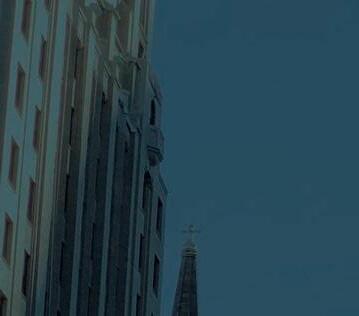
Philadelphia, Pennsylvania
SEPTEMBER 10–14, 2024
AEG’s 67th Annual Meeting will be hosted in the Hilton at Penn’s Landing Philadelphia. This year’s theme, the Geology of the Crossroads, reflects the character of Philadelphia, a city at the crossroads between south and north, between tradition and revolution, and between history and innovation.
The meeting hotel is located on the Delaware River waterfront in Center City’s Historic District and adjacent to Spruce Street Harbor Park and the Independence Seaport Museum. Within a mile of the hotel, guests may enjoy an eclectic array of restaurants and explore numerous attractions, including the Liberty Bell, the Museum of the American Revolution, the Benjamin Franklin Museum, and Society Hill.


REASONS TO ATTEND:
→ Discover new technology

→ Obtain professional development hours
→ Network with potential clients, customers, or employers
→ Learn from technical presentations
→ Gain experience by giving a technical presentation
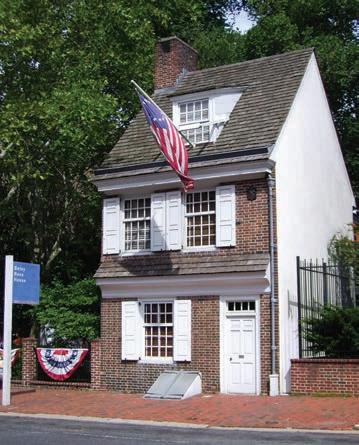

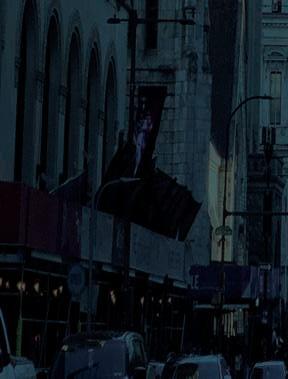

→ Build relationships for long-term career satisfaction

AEG News (ISSN 0899-5788; USPS 954-380) is published by the Association of Environmental & Engineering Geologists (AEG) four times per year: in April, July, and December, with the Annual Report and Directory in March. The Annual Meeting Program with Abstracts is published only digitally, in September, and the digital copies are distributed at the AEG Annual Meeting. Association members receive an electronic copy of all five issues of AEG News as part of their dues. Print subscription for Association Members, which includes all three regular issues of the AEG News and the Annual Report and Directory issue, is $40 in addition to annual membership dues. Nonmember annual subscription is $50. Back copies of AEG News regular issues are $12 each. Inquiries should be sent to manager@aegweb.org. © 2024 Association of Environmental & Engineering Geologists—All Rights Reserved
Views expressed in this publication are not necessarily those o cially representing the Association of Environmental & Engineering Geologists except where expressly stated.
Acquisitions Editor: Martha Whitney, Principal Engineering Geologist, Whitney Geologic, internationalaeg@aegweb.org
Content Editor: Bill Roman, Woodsman, bill.roman.bretz@gmail.com
Managing Editor/Production: Allie Boman and Whitney Larson, Boman Editing, 765-543-4191, allie@bomanediting.com, www.bomanediting.com
In order of preference:
1. Send files via email, preferably as attachments, to both email addresses above. Optimum file format is MSWord. Users of other software programs should convert their file to ASCII or text only. Photos and other images, charts, graphs, etc. should be sent as separate images but may be included in the Word.doc for placement purposes.
2. Images should be sent as high-resolution (250 dpi at 4” wide or larger) jpeg or ti files and should be named with a strong identifier such as HF-TexasJohn Jones —NOT P204679.jpg. Corresponding photo captions should be included in the text along with an attribution of the source/photographer.
3. The policy of AEG News editorial sta is to limit the credentials of an individual to two. No e ort will be made by the AEG News editorial sta to determine whether individuals whose credentials are missing from the submitted copy actually have academic or professional credentials, nor will the sta verify the existence or correctness of the credentials submitted.
For detailed guidelines visit: https://aeg.memberclicks.net/assets/docs/aeg_news_style_ guide_0713.pdf
Advertising in the News
Contact AEG at president@aegweb.org.
Susquehanna River and Conowingo Dam. Photo by Aaron Harrington (CC BY-SA 2.0). Read about President Sarah Kalika’s visit to the DC-MarylandVirginia Chapter, which included a drive across the dam (see pages 6–7). And check out the list of field courses offered at the 2024 Annual Meeting (see page 9)—Conowingo Dam is on the list!
2023–2024 Officers
President: SARAH KALIKA
Consulting Geologist, DiabloGeo Environmental, San Ramon, CA, president@aegweb.org
Vice President/President Elect: RENEE WAWCZAK Hydrogeologist, Norridge, IL, renee.wawczak@gmail.com
Treasurer: PAUL WEAVER
Geotechnical Geologist–Retired, Greensboro, NC, pmweaver187@gmail.com
Secretary: MARK SWANK
Senior Engineering Geologist, Aspect Consulting, Vancouver, WA, markswank@comcast.net
Past President: NATHAN SARACENO
Senior Geologist, DiGioia Gray and Associates, Monroeville, PA, nrsaraceno@gmail.com
Association Manager: manager@aegweb.org
AEG Foundation: Acting President Anna Saindon, rmsain@gmail.com
Martha Whitney, AEG News Acquisitions Editor
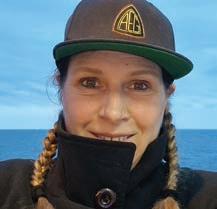
elcome to the Spring edition of AEG News. The wheelhouse of AEG is in a state of transition. We have a new AEG News Managing Editor and a new Environmental & Engineering Geoscience Journal Editor. This edition features an article honoring Dr. Abdul Shakoor as he retires, and we welcome Dr. Thomas Oommen, the new Editor of the EEG Journal. We also extend our best wishes to Andrea Ptak as she is retiring after two decades as AEG News Managing and Production Editor, and we welcome Boman Editing as they take on the role. We will soon have a new association management company to replace our former management company, which abruptly shut its doors on April 9. Members of the volunteerrun Executive Council (EC) are extremely busy managing these transitions (as well as their own personal workloads), and we are very grateful as they have gone above and beyond their normal responsibilities to keep AEG running smoothly. We hope to have the new management company in place this summer. In the meantime, the EC appreciates members’ patience as email responses and action items are subject to delays.
Chapters and Technical Working Groups (TWGs) have also been very active. This edition of the News includes updates from the following nine Chapters: Inland Empire, Nisqually, DC-Maryland-Virginia (DMV), Great Basin, Texas, Carolinas, Mile High, Puget Sound, and Cal State Los Angeles. It is great to hear from the Chapters and learn about their meetings, field trips, social events, and technical conventions, as well as organizing “Visiting Professional” presentations at local universities and colleges. The latter activity is crucial for our profession, as student enrollment (and therefore funding) in applied geoscience-related programs is decreasing.
We are grateful to the Chapters for their work toward increasing the visibility of geoscience-related options at the local level, from K–12 students to those at community colleges and universities. It is a holistic approach that is further enhanced by the work of the Diversity, Equity, and Inclusion Committee (DEIC) Co-Chair Minda Moe, who is developing a database of historically Black colleges and universities, Hispanic-serving colleges and universities, Tribal colleges and universities, and Asian American and Pacific Islander–serving colleges and universities. This database will be a helpful guide for tertiary education outreach activities and specifically for efforts toward a diverse future for the geoscience profession.
In related news, AEG is pleased to welcome four new student chapters: Appalachian State University; Rowan University; California State University, Fresno; and California State University, Los Angeles.
AEG Operational Committees are busy as well. This
issue includes updates from the DEIC and the Membership, Communications, and Student and Young Professional Support Committees (SYPSC), as well as great news from the Virginia Geologist Workgroup regarding their successes and ongoing efforts toward strengthening the Virginia Code pertaining to the practice of geology.
In late April, AEG held the Mid-Year Board Meeting in Aurora, Colorado. The meeting is attended by the EC and the Board of Directors (BOD). This year the meeting opened with a moment of silence to honor Bruce Rogers, whose obituary is included in this edition. All eleven Regional Directors were present (this year I attended virtually from my home in France), as well as Visty Dalal, Co-Chair of the Membership Committee, and Gabby Jakubowski, AEG’s Early Career Ambassador. Anna Saindon gave an update on the activities of the AEG Foundation, and Heather Clark, AEG’s Meeting Manager, provided the financial report from the 2023 Annual Meeting in Portland (a huge success!). The EC and BOD voted on several awards and agreed to a proposal presented by the Sacramento Chapter to hold the 2027 Annual Meeting in Sacramento, California (tentative dates: October 26–29). This meeting is the 70th anniversary of AEG and will honor the history and founding of AEG in Sacramento in 1957.
This edition includes obituaries for Bruce Rogers, Keith Turner, and Gary Luce. The AEG family is grateful for their service to AEG, and they will be missed.
Past President Bill Godwin shares with us news of the upcoming “On to the Future” (OTF) field trip that will be held during the GSA meeting in Anaheim, California. The OTF program supports students from diverse communities to attend GSA Annual Meetings by offering partial travel funding, meeting registration, one-year membership, mentorship, and special sessions with leadership during the meeting. The title of this year’s OTF trip is From Flooding to Faulting: The Dynamic Geology of Coastal Orange County. It is through the work of the SYPSC and DEIC that opportunities for underrepresented students and young professionals are made possible. If this is important to you, please consider joining one (or both) of these committees. For details, visit https:// aeg.memberclicks.net/volunteer-main
As Director of the International Region, I try to attend at least one or two Operational Committee meetings as time permits (it is not always easy with the 6- to 9-hour time difference). Recently I attended the Chapter Support Meeting and made my usual plea for content for the News. The idea of preparing a template for Homefront articles was proposed and is now in progress. The template will be available on AEG’s website under Member Resources. In the meantime, some suggestions for Homefront Articles can be
found at the bottom of page 10 of this issue. I also attended the SYPSC meeting and learned about their activities, which are summarized in their report in this issue. I’ve recently accepted the role of USA National Group Representative for the International Association for Engineering Geology and the Environment (IAEG). IAEG is a worldwide scientific society with more than 4,857 members and 68 national groups. AEG is the USA National Group within IAEG. As your Representative, my responsibilities include cross-pollinating IAEG and AEG events and news and encouraging AEG members to join IAEG. Members of IAEG have access to The Bulletin of Engineering Geology and the Environment, get reduced fees for participation in IAEG and National Group events, are eligible for awards from the Solidarity Fund for attendance at IAEG Congresses, and have opportunities to network with the large and diverse IAEG family. In my view,
the opportunity to network with geoscientists from around the world provides a real value toward improving our professional contributions to society on a global scale. Consider joining IAEG today!
In addition to regular membership, we are seeking candidates for the position of USA Representative in IAEG’s Young Engineering Geologist Group. If you are under 40 and would like to be involved, please contact me.
In my view, the opportunity to network with geoscientists from around the world provides a real value toward improving our professional contributions to society on a global scale.
Planning for the 67th Annual Meeting is well underway, and I hope to see you all in Philadelphia. I happened to be in Philly last year and was able to visit the Museum of the American Revolution. If you have a chance to go there, do not miss the Washington’s War Tent experience. It is truly remarkable! We hope you enjoy this issue of AEG News.
Authors alone are responsible for views expressed in signed articles. Advertisers and their agencies are solely responsible for the content of all advertisements printed and also assume responsibility for any claims arising therefrom against the publisher. AEG and AEG News reserve the right to reject any advertising copy.



Chicago is one of the top tourist destinations in the United States for a reason. It’s a welcoming city with plenty of world-class attractions. Located on Lake Michigan in Illinois, Chicago is famed for its bold architecture. In addition to engineering geology, the AEG 2025 Annual Meeting will focus on sustainability, health, climate change, and environmental geology.

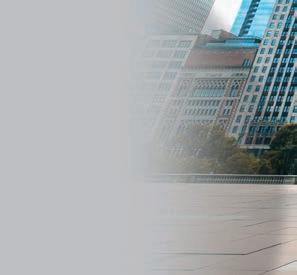



September 23-27, 2025
Chicago, Illinois | Westin Chicago River North
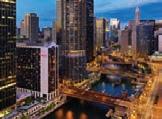
The Meeting Hotel – Located in the heart of downtown Chicago in the prestigious River North neighborhood of the city, the Westin Chicago River North’s location makes it a perfect base to explore the historic and energetic Windy City with nearby attractions including Millennium Park, Chicago theatre district, and the vibrant Chicago Riverwalk. Refreshed in early 2020, the flexible event space offers the perfect setting for meetings. Recharge in your choice of accommodations, from traditional rooms to luxury suites, all with a view of the Chicago River or the downtown skyline. Maintain your health goals with the delicious and healthy on-site dining at 320 RiverBar and the state-of-the-art WestinWorkout fitness studio. Enjoy complimentary fitness classes as well as Rise + Ride with Westin and Peloton.

Sarah Kalika, 2023–24 AEG President
t’s spring and my Presidential year has already been busy! In October, I started my Chapter tour with visits to Chicago and St. Louis. In January, I kept it local and visited the San Francisco Bay Area and San Joaquin Valley Chapters with a stop at Fresno State University —one of our newest Student Chapters! February took me to the Southern California and Inland Empire Chapters, where I additionally visited students at two California State University schools: Los Angeles (another new Student Chapter!) and San Bernardino. My trip in March brought me east to visit the DC-Maryland-Virginia Chapter and see some local geology, as well as drive across Conowingo Dam (look for this field course at the Annual Meeting), and then through Philadelphia on my way to the New York-Philadelphia Chapter. Additionally, I visited students at York College —a school of the City University of New York system. My April agenda included visiting the Oregon and Nisqually Chapters, then representing AEG at the Geoprofessional Business Association meeting in Anaheim, before joining the Executive Council and Board of Directors meetings in Denver, CO— with a stop at the Mile High Chapter!

Andie Ptak who is retiring, and a warm welcome to new Editor Allie Boman! We chose Allie after an exhaustive review of applications from prospective Production Editors and multiple interviews. We hope Allie will enjoy working with AEG for many years.
We additionally had the difficult task of finding a new AEG Co-Editor for our Journal Environmental & Engineering Geoscience. After 30 years of service to the journal, Dr. Abdul Shakoor has retired as Co-Editor, but his position is now in the capable hands of Dr. Thomas Oommen, who previously served as chair of the Journal’s Editorial Board. If you’re interested in learning more about our journal and the submittal process, a recorded webinar, “All You Need to Know About Publishing in a Peer-Reviewed Journal,” (presented in March) is available to play back by visiting our webinars page on the website.
In May I’m planning a visit to Puget Sound, then TX in July, representing AEG at the American Institute of Professional Geologists meeting in August. Hopefully, I will get out to the Carolinas in October after our Annual Meeting in Philadelphia and again representing AEG at the Geological Society of America meeting in September.
As you all know, I like to leave things better than I found them. To that end, I improved the way the Executive Council (EC) collaborates by holding twice-a-month President’s Calls that are open to the entire EC to attend and provide feedback. This has resulted in faster response times and more of the EC’s input before decisions are made. Additionally, Vice President Renee Wawczak and I provide content and weekly reviews of AEG Insider before it hits your inbox. I’m also super active on our social media sites (particularly the Facebook group). In January, I held a “State of AEG” webinar to give an overall update on AEG’s leadership, membership, financial outlook (we’re doing really well!), and volunteer opportunities. The webinar was recorded, and members can play it back, along with over 50 other recorded webinars, at no charge by visiting https://www.aegweb.org/webinars.
So far, 2024 has been a “year of change” within AEG, as we give our well wishes to AEG News Production Editor
It wouldn’t be a day ending in y without another threat to geologist licensure in the U.S. Since last spring, I have kept regular contact with the Virginia Geologists Workgroup (VGW) and AEG’s VA lobbyist. I’m pleased to announce that our goal was met for the 2024 legislative year and two bipartisan bills were passed in Virginia that redefine the practice of geology and were signed by their governor in March. These bills are the first of two steps to solidify geology licensure in VA, which means that our fundraising effort will continue for the 2025 legislative session—where AEG and the VGW hope to introduce a bill to codify a professional licensure requirement for geologists in VA. An update on this effort can be found elsewhere in this issue of the AEG News . Additionally, CA’s Board for Engineers, Land Surveyors, and Geologists is going through their regular “Sunset Review” process, which occurs approximately every four years. Our CA lobbyist has been attending these hearings, and AEG submitted a letter of support. We don’t anticipate that licensure will be impacted in CA.
Earlier this year, we were informed of a vacancy on the CA Hospital Building Safety Board—an important board established in 1973 by the Alquist Act, which requires that AEG provide an engineering geologist to serve. After advertising this opportunity, we recommended Courtney Johnson, PG, CEG —who is a perfect fit, with over 17 years of experience performing geotechnical work on hospital facilities in CA. Courtney was interviewed and approved by the State of California in February, and she was installed during their meeting in April to her four-year term.


Checking out the serpentinite at Soldiers Delight Natural Environment Area in Maryland





AAdditionally, upon the advancement of Julien CohenWaeber to the International Association for Engineering Geology and the Environment’s (IAEG) North America Vice President position, we were in need of an IAEG U.S. Representative, so Martha Whitney, who currently serves on AEG’s Board as Director for our International Region (and is the Acquisitions Editor for AEG News), was appointed. Additionally, Martha will serve IAEG as U.S. representative on the Woman Engineering Geologist subgroup. We are still looking for a representative for the Young Engineering Geologist group—so if you’re under 40 and interested in this position, let us know!
For the first time ever, AEG will be represented with a postcard-sized flyer in the American Geosciences Institute’s Earth Science Week Teacher Toolkits! These popular kits are distributed to over 9,000 teachers and AEG’s flyer contribution was achieved at a reasonable cost of under $500 to print. The flyer features the various career opportunities of applied geology and includes a QR code linked to the Students & Teachers portion of our website to provide additional information. We hope to be able to continue this contribution effort annually.
I’m looking forward to seeing you at an upcoming Chapter meeting or at our Annual Meeting in Philadelphia this September! As always, if you have any questions about AEG or any feedback, contact me at president@aegweb.org.
Renee
Wawczak, 2023–24
AEG Vice President
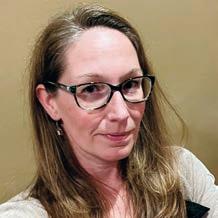
EG is a volunteer organization, and it is the passion and drive of our committees and volunteers that allows our Association to grow and flourish. As Vice President, one of my tasks is to attend as many operational committee meetings as possible and serve as a liaison between the committees and the Board. Our committees serve as the driving force of our Strategic Plan, and they discuss topics ranging from meeting planning; to governance; to membership; to diversity, equity, inclusion; to finance! Volunteer opportunities are available for a variety of backgrounds and interests. Our full list of operational committees can be found at: https:// aeg.memberclicks.net/operational-committees.
AEG will once again host a Committee Leaders Town Hall in Summer 2024! Ever wonder what another committee works on? Want to connect with other volunteers that you just haven’t met yet? Interested in hearing how the committees drive our Strategic Plan, and how your committee’s activities
and actions fit within the larger goals of the Association? Join the upcoming Town Hall to answer these and other questions you may have.
What their committee has been doing since the Annual Meeting
■ Specific goals for the remainder of the year
■ Number of committee members, and solicitation for additional members if needed
■ Committee needs (immediate/future/wish list)
■ Questions for the AEG Executive Council other Association Leadership
Additional communications and details regarding the Committee Leaders Town Hall are forthcoming, so stay tuned! And if you want to get involved, I encourage you to contact me directly at renee.wawczak@gmail.com to discuss your ideas, the needs of the Association, and how you can make a difference at AEG.
Paul Weaver, 2023–24 AEG Treasurer
AEG continues to be a financially strong organization. We ended our 2023 financial year in the black, thanks largely to a very successful 2023 Annual Meeting in Portland. A huge round of applause is owed to the Portland meeting organizing committee and to our Meetings Manager, Heather Clark, for all their hard work.
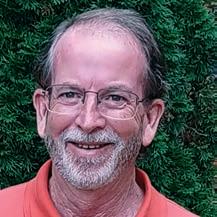
A reminder that our 2024 Annual Meeting will be held September 10–15 in Philadelphia, PA. Please put this on your calendar and plan to attend if you possibly can. If you have never attended an Annual Meeting, you are missing out on so much!
If you have not renewed your membership for 2024, please do so now. You may not realize it, but the vast majority of AEG’s operating budget comes from membership dues. These funds allow us to continue to provide the many perks of membership, including the receipt of our publications, free webinars, discounted registrations for seminars and meetings, and much more.
Corporate Sponsorships are another important contributor to AEG’s operating funds. In case you are unfamiliar with AEG Corporate Sponsorships, please review the information from AEG’s website:
As the leading organization for applied geology, AEG offers sponsors and advertisers the opportunity to reach a targeted audience for their products and services. Over 2,600 AEG members actively practice in the areas of engineering geology, environmental geology, and hydrogeology. Most of our members arepracticing professional geologists with the
responsibility for selecting contractors and subcontractors, so AEG is a great place to showcase your products and services to find new customers. Members regularly purchase software, field equipment, instrumentation, office and field supplies, geologic support services, analytical environmental and geotechnical laboratory services.
Corporate sponsorships demonstrate vendor commitment to advancing the field of applied geology and creates high visibility for sponsoring companies within the AEG membership. Our members appreciate companies that support their professional organization.
AEG has multiple ways to reach your target audience; by becoming a corporate sponsor, you can take advantage of the opportunity to be featured in multiple outlets and put your company name in front of our members throughout the year. AEG offers several levels of sponsorship, but they all have one goal: to keep the sponsor’s name in front of our members and to bring you business.Packages start as low as $500!
AEG also appreciates that not all companies provide nationwide service. Sponsorship opportunities are available to provide local support to AEG Chapters in those areas your company is present in while receiving national recognition for that support. Contact us, and we will develop a customized sponsorship that provides the attention your company deserves.
For more information, contact heather@aegweb.org or call 303-518-0618.
AEG is not only committed to helping our members accomplish their goals, but we want our sponsors and supporters to succeed as well! Don’t miss your chance for exposure to tons of readers that are looking to find out more information on the Annual Meeting and other AEG happenings. Don’t miss your chance to reach such a vast, influential audience! Place an ad in the next edition of the AEG News.
1 Conowingo Dam, Maryland (Pictured)
2 Wissahickon Valley, Philadelphia, Pennsylvania
3 Absecon Island & Brigantine Island, Atlantic County, New Jersey
4 Edelman Fossil Park
5 Valley Forge
Visit https://www.aegannualmeeting.org/field-courses for more info.
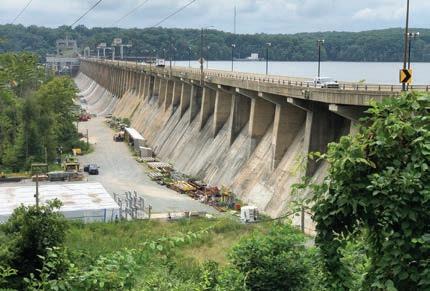
Mark Swank, 2023–24 AEG Secretary

ust when we think everything is going as planned, life finds a way of ramping up the unpredictable and realigning our expectations. For several years, AEG’s Executive Council (EC) has made concerted efforts to protect our finances, stabilize our governance, and support our members through meetings and webinars. Yet, here we are, working through rapid changes in our association management, and the EC temporarily taking on day-to-day operations until a new business manager is selected.
As the EC’s Secretary, my main responsibilities consist of:
Taking and distributing minutes during our EC and Board of Directors (BoD) meetings. The EC has a full-day meeting four times a year. The summer and winter EC meetings are all-day conference calls while the spring and fall meetings are in person and joined with the Mid-Year BoD meeting and the Annual Meeting, respectively.
Reviewing and providing secondary review of invoices and inputting, updating, and advancing our shared spreadsheet with the action items from our EC and BoD meetings.
Maintaining our list of Regional Directors and their terms, and communicating these elections to our membership. This summer, we will have the following region elections:
Region 3: Pacific (Chip Barnett incumbent, eligible for additional term)
Region 5: Mountain Prairie (Denise Garcia incumbent, eligible for additional term)
Region 8: Southeast (Hawkins Gagnon incumbent, eligible for additional term)
Traditionally, these elections have been managed by our association management company, with the votes tabulated and reported to the organization by the Secretary. With the loss of our association management, this year, as Secretary, I will also be responsible for coordinating the elections.
Regional Directors serve in the position for three years, not to exceed two consecutive terms. AEG needs your insight, enthusiasm, and ideas. Please consider submitting your nomination today! The benefits of serving in a Regional Director role are numerous and include leadership training and growth, gaining organizational and budgeting skills, networking through all aspects of the organization, gaining an understanding about how the BoD works to address membership concerns, engaging and supporting the profession, and acting as a mentor to early career and new members.
Even though I have been a part of AEG for many years, including terms as Oregon Chapter Chair, Pacific Regional Director, and AEG BoD member, I now have an even better appreciation of the dedication of our AEG leadership. The commitment of our EC, and particularly Sarah Kalika our current President, has been extraordinary over the past two months during the dramatic change in the association’s management, and will continue for the foreseeable future. I could not be prouder to be part of this group.
Speaking of which, AEG’s numerous operational and technical committees are run by our member volunteers, and they are the heart of our organization, ultimately determining our focuses and priorities. If you’ve ever wondered why you see and hear more about some committees than others, it directly correlates with the energy of those active volunteers. If you think AEG should have more focus on other technical issues and have not seen enough on those topics, stop waiting for others to do what you can lead—and volunteer! Go to the “Volunteer” tab on our website, and click on “Operational Committees” and/or “Technical Working Groups.”
I’m looking forward to continuing my service to AEG, and I hope that you will too. I hope to see you all at the Annual Meeting in Philly this September!
■ Location and field trip title
■ Who were the trip leaders and what are their affiliations?
■ Approximately how many folks attended the field trip; were there any Student Chapter members?
■ Was it an all-day event? Half-day?
■ Did folks gather for a meal (i.e., box lunch provided, or lunch at a restaurant)? Did attendees meet up somewhere after?
■ Was there a Chapter meeting before/after the field trip?
■ What were some of the topics of discussion at the outcrop/ overview/site?
■ What are some of the past studies of the site? Are there ongoing or future studies planned to investigate certain aspects of the site?
■ High-resolution field trip photographs are always welcome!
The Homefront is not just about field trips! Monthly meetings, guest lectures, student poster nights, Student Chapter activities, community outreach, social events, member publications . . . all Chapter news is AEG News. Publishing your Chapter’s news increases visibility and encourages others to get involved. Please send your contributions to internationalaeg@aegweb.org.
William Godwin
AEG will be leading and sponsoring a geology field trip as part of the Geological Society of America (GSA) Connects meeting to be held in September of 2024 in Anaheim, CA. The one-day field trip (September 21) is planned for On To the Future (OTF) students and young professionals, who are from groups that are typically underrepresented in the geosciences or who may be nontraditional students. AEG and GSA believe that this is an opportunity for these students to be exposed to applied geoscience careers and hands-on field experiences. AEG Student Members are eligible to sign up for this field trip also. This effort builds on the successful efforts last year by Cynthia Palomares (Past President and current Jahns Distinguished Lecturer) along with others who planned and hosted a virtual field trip (VFT) as part of the 2023 GSA meeting in Pittsburgh, Pennsylvania. The VFT was led by James V. Hamel, PhD, PE, PG, and explored the Interstate Route 79 and Toms Run Nature Reserve landslide areas.
This year we will have an in-person event to take advantage of the typically excellent southern CA weather and to highlight several themes, as stated in the title of this field trip, “From Flooding to Faulting: The Dynamic Geology of Coastal Orange County.”
The overall itinerary is currently in the planning stages and is described as follows: Field trip attendees will embark on a comprehensive exploration of the geological resources and challenges shaping coastal Orange County, CA. This field trip will explore three distinct yet interconnected facets: surface water flooding, subsurface groundwater dynamics, and earthquake hazards. Field trip leaders will describe and demonstrate the historical influences of the Santa Ana River’s meandering
course and destructive flooding events, which have shaped the surface water landscape over the centuries. Delve into the intricate coastal aquifer systems, where historic sea level changes and tectonic uplift have given rise to vital water resources, while also posing threats of seawater intrusion as global sea levels rise into the next several decades. Lastly, navigate the seismic landscape, where the Newport-Inglewood Fault Zone creates both a helpful groundwater barrier and a potential earthquake risk, as demonstrated by the historic 1933 M6.4 Long Beach earthquake. Join us on this geologic journey as we unravel the intricate tapestry of coastal Orange County’s fascinating geological history and the pressing challenges it faces today and into the future.
Planning for the field trip is being organized by Brian Olson, PG, CEG (Trip Leader); William Godwin, PG, CEG (Co-Leader); and Paul Burgess, PG, CEG (Co-Leader). Additional planning support will be provided by Robert Leeper of Mt. San Antonio College and local professionals with the Orange County Water District; University of California, Irvine; and USGS. Steve Boss, with Geosciences ASCEND and the University of Arkansas, has also been critical in obtaining grants to support the trip.
Look for future updates in AEG News and AEG Insider and for information on how to sign up for this worthwhile event.
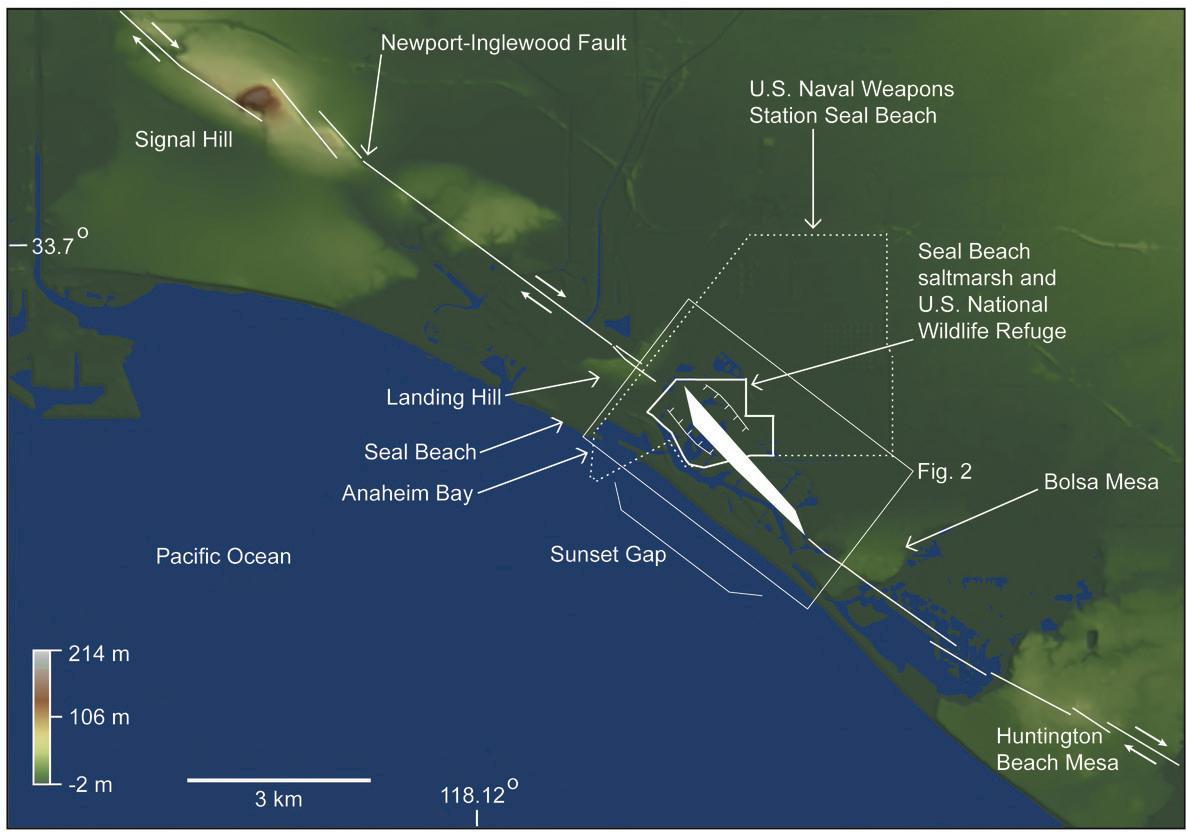
Nichole J. Vetter, PG, AEGF Director
The AEG Foundation raised just over $100,000 and was able to award 18 scholarships totaling $55,000 in 2023! It is supporters like you who made that possible. Because of you, students and professionals can focus on becoming great environmental and engineering geology practitioners. With your continued support, the AEG Foundation would like to increase the number of scholarships and grants that we can provide in 2024. If you would like to make a donation, please visit https://aegfoundation.app. neoncrm.com/forms/donate. You can make a one-time donation or get set up to make a monthly donation to your chosen fund(s).
The AEG Foundation is excited to announce that a space has been created to tell the story of the Foundation and of all the students, professionals, and teachers that have benefited from over $400,000 of scholarships and grants. Come take a look at the AEGF Blog https://aegfoundation.org/blog/! If you are a past recipient and would like to submit an article, please reach out to staff@aegfoundation.org.
Owner: Caltrans
Product: Maccaferri RockMesh 3030 Pinned Drapery www.maccaferri.com/us


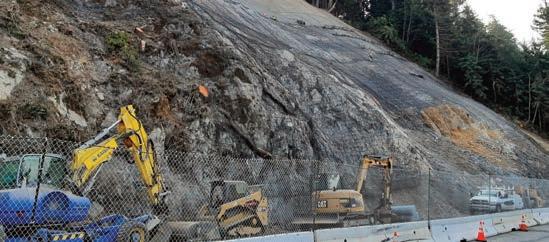
Tim Shevlin
Tim.Shevlin@geobrugg.com www.geobrugg.com

Maccaferri North America
Mike Koutsourais
m.koutsourais@maccaferri.com www.maccaferri.com/us
Bill Male bmale@scintrexltd.com https://scintrexltd.com


University of Pennsylvania lps@sas.upenn.edu https://www.lps.upenn.edu /hs/msgo

Tony Monasterio tmonasterio@bgcengineering.ca www.bgcengineering.com
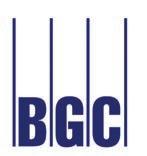
Southwest Geophysical Consulting, LLC
Dave Decker, dave@swgeophys.com https://swgeophys.com/
Sarah Kalika, skalika@diablogeo.com diablogeo.com
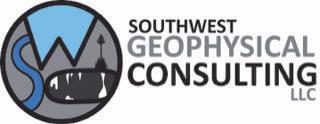

Eldon Gath gath@earthconsultants.com www.earthconsultants.com

AEG is pleased to announce that Dr. Thomas Oommen, Professor and Chair of Geology and Geological Engineering at the University of Mississippi, has been appointed as Co-Editor of Environmental & Engineering Geoscience (E&EG). E&EG is a joint publication of AEG and the Geological Society of America (GSA) and is published quarterly.

Dr. Oommen received his PhD in geotechnical and geo-environmental engineering from Tufts University in Medford, Massachusetts. His research is focused on geohazard characterization and risk reduction using remote sensing and artificial intelligence. Dr. Oommen has extensive teaching, research, and consulting experience in geohazards, sustainable development, community resilience, infrastructure monitoring, asset management, engineering geology, and transportation geotechniques. Dr. Oommen has authored two books, eighty-five journal publications, and numerous conference publications. He has received over $9 million in research funding. Dr. Oommen is a past Chair of the GSA Environmental and Engineering Geology Division, Chair of the American Society of Civil Engineers Engineering Geology and Site Characterization Committee, and the Chair of the E&EG editorial advisory board. Dr. Oommen has been a keynote speaker and panelist for several international meetings and conferences.
Dr. Oommen replaces Dr. Abdul Shakoor, who is retiring after serving as Co-Editor of E&EG for thirty years.
Brian Greene, PhD, PG; Dale Andrews, PG; Matthew Morris, PG; and Nathan R. Saraceno, PG
Professor Emeritus Abdul Shakoor, retiring Co-Editor of Environmental & Engineering Geoscience (E&EG), leaves an indelible legacy that merits recognition. Abdul has served the Association as Co-Editor of E&EG for twenty-seven years and his contributions are extensive.
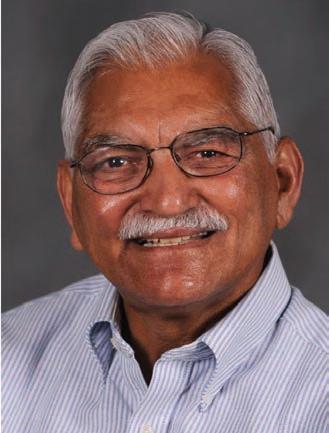
Abdul was introduced to AEG by his advisor and longtime friend, Professor Terry West during the 1968 Chicago Annual Meeting and served as the Editor of AEG News for five years (1993–1997). This experience led to his desire to further contribute to the Association, and in 1997, following the untimely passing of Professor Norm Tilford, Abdul stepped into the role of AEG Co-Editor for E&EG, alongside Dr. Kerry Cato and Geological Society of America (GSA) Co-Editor Professor Jack Sharp. This period marked a unique collaboration, as this was the only time in the history of E&EG that the Journal had three editors. Over twenty-seven years, from 1997 to 2024, Abdul oversaw the publication of twenty-nine volumes of the Journal, in addition to guiding numerous Special Publications covering diverse topics, including dams, landslides, karst, and naturally occurring asbestos. Over two hundred peer-reviewed professional papers were published under his leadership.
AEG Members enjoy access to Environmental & Engineering Geoscience
Read at https://www. aegweb.org/e-eg-journal-nm
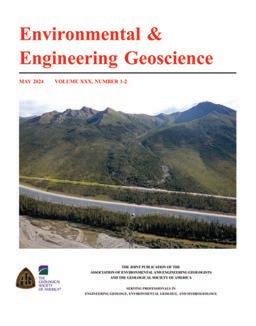
Abdul’s long service as Co-Editor of E&EG transcends these impressive facts. He found this role a rewarding experience and was honored to serve both AEG and GSA. Abdul gratefully acknowledges the hard work of the numerous and diverse group of individuals that made contributions throughout his tenure. These included authors who shared their expertise, peer reviewers who meticulously evaluated submissions, GSA Co-Editors who collaborated closely, Associate Editors who ensured quality, and Special Journal Editors who curated thematic issues. Notable recognition goes to Abdul’s dedicated Editorial Assistant, Karen Smith, whose critical contributions made meeting the tight E&EG quarterly publication deadlines possible.
Abdul relished this role because it contributed to his unwavering commitment to nurturing the next generation. He has mentored and encouraged countless students—from both his own academic circle and other AEG chapters—to publish their graduate research as well as relevant research gleaned throughout their careers. His focus on empowering
young members has left a lasting impact on the geoscientific community.
Abdul cherished the opportunity to present the yearly AEG Best Publication Award and the Outstanding Reviewer Award at AEG Annual Meetings. This was a highlight for him and an inspiration to many in our AEG membership to submit their papers to the Journal and to volunteer to serve as peer reviewers.
Dr. Abdul Shakoor’s legacy will undoubtedly continue to inspire and shape the future of our Association, and we thank him dearly for his unwavering dedication. With his departure from this role, we look forward to E&EG’s continued success under Dr. Thomas Oommen’s leadership, alongside his GSA Co-Editor Dr. Eric Peterson, the Associate Editors, and the dedicated authors and reviewers who contribute their time and expertise.
Thank you, Abdul, as AEG sincerely appreciates your mentorship, professionalism, dedication, and service.
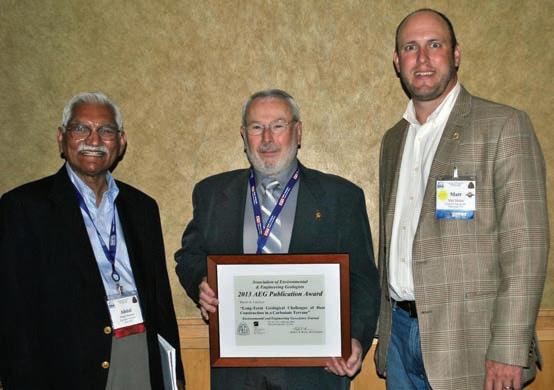
Students, Early Career Professionals, and Teachers: Are you planning to attend the Annual Meeting but need travel assistance?
Apply for one of five $500 travel grants awarded by the Students & Young Professionals Support Committee.
Applications are due July 31, 2024.
Each travel grant will be awarded by August 2024 and is considered a reimbursement, which requires submitting an expense report with receipts to AEG HQ.
AEG expects 500+ attendees at the 2024 Annual Meeting in Philadelphia, PA, scheduled for September 10–14. Attendees browse exhibitor booths during the Icebreaker, the Exhibitor Luncheon, and breaks. For information, contact AEG Meeting Planner Heather Clark. https://www. aegannualmeeting.org/sponsors-and-exhibitors.
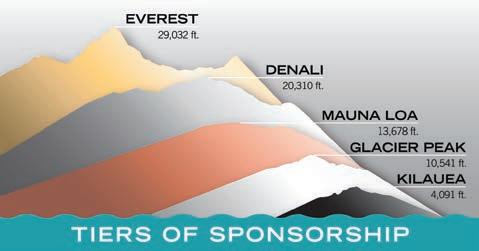
Listing in all issues of AEG News ($800 value)
Company logo with link on the AEG website homepage ($3,000 value)
Recognition at the AEG Annual Meeting
“Shout Out” three times on AEG’s Social Media Pages ($250 value)
Sponsor Spotlight (up to 200 words)
The Landslide Technical Working Group (TWG) met regularly during the past year, three times via video conference and once at the AEG Annual Meeting. James has served as the Co-Chair of the TWG since volunteering at the 2022 Annual Meeting, and April stepped forward to help as Co-Chair early in 2023.
Our group is reaching out to our counterparts in the Canadian Geotechnical Society to coordinate planning of the 4th North American Symposium on Landslides (NASL).
The TWG successfully hosted three technical sessions at the 2023 AEG Annual Meeting – two on landslides and one on post-wildfire debris flows.
We are also planning events for the next AEG Annual Meeting, which may include technical sessions, a joint symposium with the Dam and Levee TWG, and a Fundamentals of Landslides short course. If you are interested in contributing to the planning efforts for any of
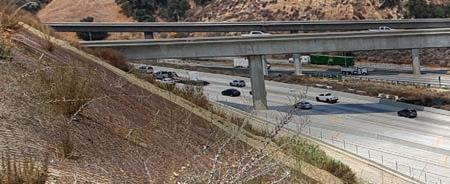

these events, please reach out to James.
Lastly, we are coordinating with USGS staff to provide expert advice on the implementation of the National Landslide Preparedness Act. For those unfamiliar, this act expands the existing landslide hazard program at USGS to include developing a national strategy for landslide loss reduction and a publicly accessible database of landslide hazard and risk.
More information on the act is available on the USGS website (https://www.usgs.gov/programs/landslide-hazards/science/ national-landslide-preparedness-act).
If you have an interest in landslides and how we study, classify, rate, and mitigate them, please consider joining our Working Group. We are looking forward to bringing new professionals and new technologies into the field of landslide research to serve the public and prevent loss of life and property.
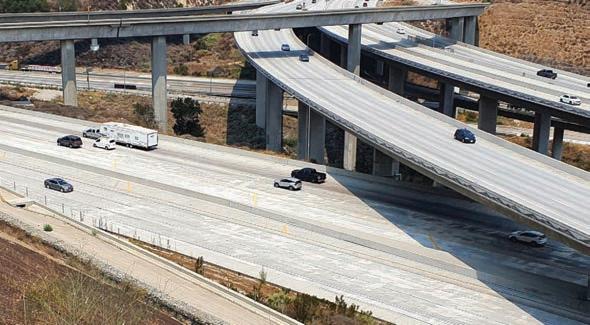
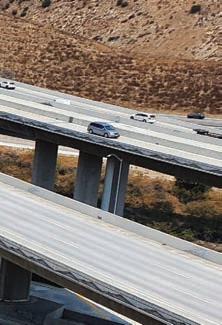


Minda Moe, Co-Chair
In the geosciences, there are many topics of conversation for an industry professional that could frighten a casual observer – earthquakes, eruptions, contamination. Diversity, equity, and inclusion (DEI) has similarly become a hot-button phrase. Some people are taken aback because they may not fully understand the meaning, or they mistakenly think that it will have a negative impact upon their lives (similar to a table of geology undergraduates in a restaurant yelling about seismic activity near a local volcano).
As discussed in the AEG News Winter 2023 issue, increased diversity adds to the technical excellence of our organization and professional development opportunities in the geosciences. AEG established the Diversity, Equity, and Inclusion Committee (DEIC) in September 2020 to focus on concrete steps that the organization could take to improve equity in the organization. Since then, the DEIC has expanded its scope to also consider how to improve equity in our profession as a whole.
Part of the mission of the DEIC includes attending calls and lectures given by other professional societies and groups in order to hear what they are working on and gain insights that can strengthen AEG’s services for our members. Cynthia Palomares, DEIC member and current Jahns Lecturer, attended a GeoASCEND community call in January 2024 that centered on recent Supreme Court rulings against affirmative action and Texas’s legislation banning DEI programs at state public colleges and universities. Whenever state-specific legislation hits the news, it might seem easy for people in a privileged position to declare that they’re going to avoid that area until the local politics become more friendly to whatever demographics are affected by the legislation. However, that approach doesn’t help the people who already live in those areas, and many people who are negatively affected by those policies cannot easily uproot their lives to move. For geoscience professionals, such a move could take us away from family and community, as well as long-term projects, employers, or even the jurisdictions where we have licensure.
On the recent GeoASCEND call, academics were concerned about how they could help their students navigate potential loss of resources when DEI program bans go into place. The DEIC call in January 2024 focused on how committee members can support AEG student members who
may be affected. Mentoring was one of the most essential means of support discussed.
Past DEIC Co-Chair Jenn Bauer regularly attends the American Geosciences Institute’s (AGI’s) Intersociety DEI Committee calls. Jenn shared the online presentation “Collectors, Nightlights, & Allies, Oh My!: Advice for Strengthening Cross-Racial Mentoring Relationships” with the DEIC via email before our January 2024 call. In that presentation, Dr. Marisela Martinez-Cola proposes three categories of cross-racial mentoring relationships: collectors, who seek out Black/Indigenous/People of Color (BIPOC) mentees to display as symbols of their own commitment to inclusion; nightlights, who use their privilege to help BIPOC mentees in majority-White spaces; and allies, who build real relationships with their BIPOC mentees and help them become their best selves.
If you are able to mentor a student interested in the geosciences – via mentoring programs within AEG, through other professional societies, or at your workplace – consider how you are interacting with your mentee’s whole self. If your mentee comes from a different background than you (firstgeneration, nontraditional student, etc.), lean into considering how your experience of the industry may be influenced by who you are, and what advice and help you can give to someone who may face additional challenges. The AGI presentation indicated that nightlights and allies encourage their mentees to apply for scholarships (not just diversity scholarships!) and help review their applications before submission. The GeoASCEND call emphasized the importance of including information in applications about the specific hardships that students have encountered, such as discrimination or difficulty navigating the complex financial aid systems because they are first-generation students.
As always, thank you for considering ways to support our organization and our profession. If you’re interested in mentoring students, please consider supporting the Student and Young Professional Support Committee (SYSPC) by emailing the SYSPC Co-Chairs, Rick Kolb (rick.kolb1@gmail. com) and Francisco Saldana (fsaldana@gfnet.com). If you’re interested in focusing on DEI issues in the geosciences, please contact DEIC Co-Chairs Minda Moe (Minda.Moe@arcadis. com) and Matt Buche (matthew.buche@water.ca.gov).
Visty Dalal and Rick Kolb, Co-Chairs
The Co-Chairs of AEG’s Membership Committee (MemCom) are pleased to present the Committee’s second report to AEG News since its inception at the AEG Board of Directors meeting following the Portland Annual Meeting in September 2023. This report describes some of the strides MemCom has made in the past six months and sets forth plans for future growth in AEG membership.
MemCom analyzed the list of nonmembers (“prospects”) who registered for the 2022 and 2023 Annual Meetings in Las Vegas, NV, and Portland, OR, respectively, to initiate contact regarding joining AEG. The email sent to prospective members listed the many membership advantages, benefits, and resources available to AEG Members, which they too could enjoy by joining AEG. Since September 2023, 178 new Members joined AEG; most of the new Members are students (both domestic & international), which indicates that AEG is attracting a younger, college-aged, demographic that is interested in AEG’s mission and goals. With the positive results shown above, MemCom is committed to repeating the above-mentioned method of contacting prospective members after every Annual Meeting to provide encouragement and incentives to join AEG.
MemCom suggested revisions (field trip picture, testimonials, membership categories, etc.) that were incorporated in a revised membership brochure. The new brochure has been uploaded to AEG’s homepage and social media sites (Facebook, X, etc.) and will be referenced in AEG News and AEG Insider frequently. In addition, MemCom suggests that the electronic copies of the brochure be circulated to all the AEG Chapters and Regional Directors so that they can share it with their Members. Lastly, during the Jahns Lecture presentations, one of the last slides should be the membership brochure to provide information to the attendees. Print copies of the new brochure will be available at the AEG membership booth. MemCom is committed to updating the membership brochure by October of each year with new information from the current year. This will provide Members with updates each year and keep them current on AEG’s activities. The revised brochure is available at http://aeg.memberclicks.net/assets/brochure/ MembershipBrochure.pdf
MemCom Co-Chairs revised the membership renewal reminder emails that were sent in December, January, and February to Members who had not renewed their membership. The responses from Members informed MemCom of the reasons they had not renewed. Members retiring from their professions didn’t see the need to keep in touch with AEG. MemCom reached out to the retiring Members to inform them about the Senior Emeritus and Emeritus categories that they could be eligible for. MemCom now has a better understanding of the needs of the Members who don’t want to continue membership in AEG and has provided AEG’s Executive Council (EC) with a short list of recommendations for revision of AEG’s membership categories.
In February 2024, MemCom compiled and sent to the EC a list of recommendations for revisions to AEG membership categories for their consideration and approval at the midyear board meeting in April 2024. Recommendations included creating a new membership category that would give an organization an opportunity to enroll five, ten, or fifteen Members under a new ‘ Institutional Membership category. MemCom also recommended that EC consider giving reduced membership fees and registrations for Annual Meetings to public-sector employees, who are generally less wellcompensated than their private-sector counterparts. Lastly, like other geological organizations in the country, AEG could give a six-month or one-year free membership to Annual Meeting and technical conference attendees to provide them an opportunity to become familiar with AEG before becoming a sustaining Member.
To enhance AEG’s exposure throughout the year with its Members and nonmembers, it is a good idea to have subliminal reminders such as AEG fridge magnets, posters, etc., that can be displayed at home or in offices throughout the year. These can be given out to all attendees at Annual Meetings and other events. The AEG President and Jahns Lecturer can share these items at meetings where they speak. The items can be designed to include AEG’s website address and phone number, with a colorful field or conference picture in the background.
MemCom Members hold memberships in other AEG’s operational and technical committees, where they try to advance MemCom’s goals and mission of recruiting and retaining Members. MemCom is grateful to AEG News and AEG Insider for including articles, reports, etc., that publicize its efforts. MemCom requests all AEG Members to make a concerted effort to reach out to their peers and colleagues in our profession to inform them about AEG’s membership benefits.
MemCom plans to use the two-pronged approach (recruiting and retaining) in enhancing AEG membership in the next six months. It has accomplished much in its recruiting goals since its inception in September 2023. Committee Members will now formulate plans to retain AEG Members who may or may not plan on leaving the organization. Ideas and plans will be polled (using surveys) from all membership to examine the reasons why some Members are “flight risks”! MemCom will reach out to AEG Chapters to recruit new committee Members.
Please check the following websites for more information:
1. AEG Membership Committee (MemCom): https:// www.aegweb.org/membership-committee
2. AEG Membership Categories: https://aeg. memberclicks.net/member-renewal-options
3. AEG Membership Brochure: http://aeg.memberclicks. net/assets/brochure/MembershipBrochure.pdf
William Godwin and Isaac Pope, Co-Chairs
Your Communications Committee has been busy this past year both organizing and supporting various efforts to communicate the message of AEG. Our monthly calls usually have between five and ten members with discussion and actions items on a variety of topics. Below are some highlights of the past year and examples of what your Communication Committee has been doing.
AEG Online Webinars/Forums: Since the pandemic in 2020, the Committee has supported various webinars that include technical topics, general geology, and preparation of Association of State Boards of Geology licensure exams among others.
Environmental & Engineering Geoscience: This joint publication of AEG and the Engineering Geology Division of Geological Society of America (GSA) has undergone a recent change of AEG editor duties with long-time committee member Dr. Abdul Shakoor passing the torch to Dr. Thomas Oomen. The editors still have a challenge to obtain submittals for peer-reviewed entries. We held a webinar in early March titled “All You Need to Know About Publishing in a PeerReviewed Journal,” whereby Oomen and Eric Peterson, GSA co-editor, explained the nuances of the publishing process. The current focus is to encourage special editions with common themes and to use virtual or specialty conferences as a springboard for publishing content. Submission of technical notes and short case histories highlighting new and innovative approaches is also encouraged.
AEG News: The three regular issues (Spring, Summer, and Winter) of this publication provide a diverse forum to share updates from AEG’s Executive Council (EC), what is happening at the Chapter and Regional levels, the activities of AEG’s operating committees and technical working groups, plus short technical contributions as well as news of the profession and upcoming events. The Annual Report and Directory issue is published in March or April, and the Annual Meeting Program with Abstracts issue is published digitally in conjunction with AEG’s Annual Meeting. We have a dedicated acquisitions editor (Martha Whitney, who also is the International Region Director) and content editor (Bill Roman). Both are volunteers who have worked collaboratively for several years with our retiring managing editor and production manager (Andie Ptak). Andie’s replacement (Allie Boman) assumed the role with the recently published 2023 Annual Report/2024 Directory issue. The EC and the Communications Committee appreciate Andie’s gracious assistance in identifying and cooperating with her replacement to assure a smooth transition of the managing/ production editor position.
Geology of the Cities of the World Series (COWS) and Special Publications: The editorship of this long-time effort to publish informative documents on the geology of selected cities and metropolitan areas in the world has been bolstered by the efforts of the new editor Terry Cordaro, with support from Trinda Bedrossian and Curt Schmidt. Since the initial publication in 1982 for Denver, the series has grown to cover 27 cites, both within the U.S. and overseas. Free access to digital copies of these publications is a benefit of AEG membership. Currently Terry and the Committee are working on issues covering Philadelphia, New York, Chattanooga, and St. Louis.
AEG Special Publication No. 31, released last fall, is titled, “Urban Landslide Hazard Mapping: A Case Study in Orinda, California, USA.” Its authors are Drs. J. David Rogers, Dan Wang, and Rune Storesund. This publication is open access and can be viewed on the AEG website. Shakoor and Bill Godwin provided technical review of the comprehensive and extensive work. Thirty special publications have preceded this one, addressing a variety of topics.
AEG Website and Social Media: The website obviously serves as a very important repository resource for the Association, and the Committee intends to support any and all changes that benefit our members. The website and the key utility Memberclicks provide a way of communicating the AEG message to the outside public. The Committee will be increasing our role in these online platforms in collaboration with the AEG Board of Directors to focus on the AEG Strategic Plan.
Francisco Saldana and Rick Kolb, Co-Chairs
The Student and Young Professional Support Committee (SYPSC) is a dynamic and collaborative committee in AEG. We act as AEG’s pipeline to serve Student and Early Career members, who represent the future of our profession. Our committee consists of early career professionals and longtime AEG members who understand the importance of the early stages in your career. The number one goal of our committee is to bring value to students and early career professionals, something that can be challenging for any organization without proper leadership, new ideas, and desire for growth.
As early career professionals, we are often fueled by our curiosity. This curiosity and our willingness to learn often have some of the most profound effects.
• A resume-writing webinar. Having heard many requests from students in the past asking for help on writing and reviewing resumes for students, our committee led the effort at AEG to hold the resume-writing webinar, recently held on May 1.
• Once-a-year career panels in the fall, with both younger and older professionals as panelists. These panels show students and young professionals the types of careers that are available and the career experiences of the panelists.
As early career professionals, we are often fueled by our curiosity. This curiosity and our willingness to learn often have some of the most profound effects. At SYPSC, we are always looking for ways to help and fuel that curiosity and provide a helping hand in any way feasible.
Our committee is tasked with planning and hosting webinars, reviewing grant applications, performing outreach to existing Student Chapters at universities across the U.S., and planning events. We are always open to new members who are willing to play an active part in our committee. If this seems like something you’d like to be a part of, we welcome your involvement. Please reach out to one of the co-chairs and we can provide you with additional information.
Our activities include:
• Twice-a-year webinars on how to prepare for and take the ASBOG (National Association of State Boards of Geology) Fundamentals of Geology (FG) exam. Since 2021, we’ve held these webinars six times, typically a couple months before each exam. Attendance has ranged from 60 to well over 100 people, including both members (who attend for free) and nonmembers, who pay $20. We held the last FG webinar on February 5 and are planning the next webinar for early August, two months before the October 4 exam.
The committee also:
• Reviews the applicants and selects the chapters that receive annual Student Chapter Grants.
• Reviews the applicants and selects the chapter that receives the annual Outstanding Student Chapter Award.
• Reviews the applicants and selects the students and young professionals that are awarded Annual Meeting Travel Grants for AEG’s Annual Meeting.
• Assists AEG’s Early Career Advocate in preparation of the Student Chapter Newsletter.
• Provides assistance to universities and colleges that wish to establish a Student Chapter of AEG.
The committee helps plan the Annual Meeting events and activities:
• Plans the Young-at-Heart reception.
• Pairs and notifies mentors and mentees for the Mentor Forum (we always have many more mentors than mentees).
• Plans the Student/Professional Networking Event.
Osward Muza
My name is Osward Muza, and I’m from Mashonaland West Province, Zimbabwe. I completed my National Diploma in Mining Geology with Zimbabwe School of Mines and am currently looking for more opportunities for career development.
Being a geology student is a journey filled with excitement, discovery, and challenges. From exploring the Earth’s crust to understanding the forces that shape our planet, a geology student delves deep into the mysteries of the world beneath.
Mining geology students develop understanding about the geological processes that govern the formation of mineral deposits, and they seek to acquire essential skills that are fundamental to success in this field: geological mapping, mineral identification, evaluation, sampling methods, testing procedures, and data analysis.
One year of my studies was dedicated to on-thejob training at a mine site in the Mutorashanga area of Mashonaland. This experience benefited me greatly as a mining geology study, as I was exposed to practical field geology and mine-related work.
My assignment was at an open pit mine, which was situated within an area of previous subsurface mining. The open pit mining had reached the level of old underground workings, which made the open pit mine unstable. The resulting safety issues hindered the extraction of ore, as well as all other mining operations. My problem-solving project was to explore for mineralization across the area of the mining claim so that the mining company could develop other areas of the site. The first stage consisted of digging trenches and mapping the prospective target area. The next phase of subsurface exploration featured percussion, reverse circulation, and diamond-core drilling, as well as geotechnical, core, and lithological logging.
Through the mapping exercise, we discovered that certain types of vegetation can indicate the rock type within that area. We also aimed to delineate the type of structures affecting mineralization; at this site, the faults, foliation, veins, and folds controlled the mineralization. Identifying certain types of sulphides and their concentrations, whether massive or disseminated, was also important. The information was crucial to the project as it would influence the decision on whether mining operations would commence.
One of the most thrilling aspects of being a geology student is the opportunity to conduct fieldwork. From hiking through rugged terrain to collecting rock samples, fieldwork allows students to apply their knowledge in real-world settings and uncover hidden geological treasures.
I have been an International Student Member of AEG since 2022. I would like to express my appreciation to AEG for giving young geoscientists a platform to learn and contribute more to the geosciences.
I greatly benefited from the practical Geocommunication
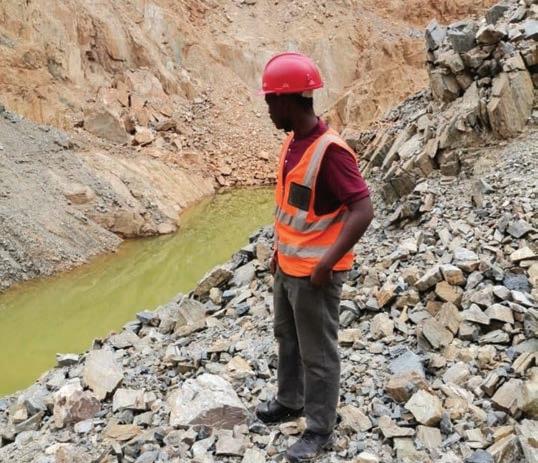
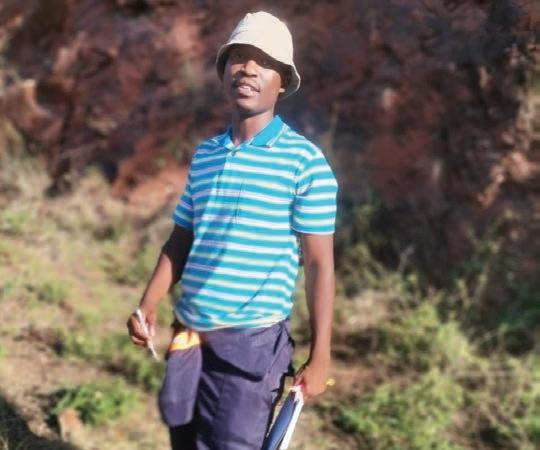
3.0 course, which was facilitated by AEG and Geologize Ltd. I would like to see more interaction between AEG and International Student Members, disposing more resources, mentorships, and scholarships for career development.
As I gaze into the future of my geology career, my aspirations and ambitions soar high. From delving deeper into the realms of geochemistry to exploring the frontiers of planetary geology, a world of possibilities waits to be uncovered. My ultimate goal is to leave a lasting impact on the field of geology and inspire future generations of rock enthusiasts.
I am currently seeking opportunities for career development, including scholarships, graduate-level training, and internships; geology technician jobs would also be highly appreciated. muzzaoswardmo@gmail.com
(January 7, 1960 – January 5, 2024)
Submitted by Caitlan Howard, Nashville Chapter Vice-Chair
We are all mourning the loss of one of our great leaders. It is with a heavy heart that we announce that A. Bruce Rogers, PG, our Southeast Regional Director, passed away on Friday, January 5, 2024.
Bruce was a great geologist and an amazing human. He was one of those people you immediately like. He cared deeply about his family, community, teammates, and profession, and those who knew him treasure the philosophical discussions he was known for, as Bruce thought deeply about things.
Bruce served diligently as a senior geologist in the U.S. Army Corps of Engineers (USACE) Nashville District since 2017. His work spanned dam safety, engineering geology, and environmental geology. Prior to serving his country, Bruce worked in the private sector in Kentucky for over thirty years. Away from work, he coached youth baseball for his daughter’s teams, taught environmental science education courses for his daughter’s school, served as judge for their annual science fairs, and performed environmental presentations for their annual Earth Day and Career Day events.

Bruce’s dedication to the geology profession was instrumental in the founding of AEG’s Nashville Chapter. He served as Chairman of the Nashville Chapter and focused on reaching out to colleges and K–12 programs to get young people interested in the geosciences. In particular, he was a supporter of the Pine Mountain Settlement School in eastern Kentucky, which offers environmental education programs to people of all ages, from college students and adults to preschoolers. In 2022, Bruce was elected to serve as AEG’s Southeast Regional Director, and in this position, he continued his focus on educational outreach.
In a group, he was the type of person who you didn’t always realize was leading. Sometimes, as with AEG, he was out front (as Nashville Chapter Chair and member of the
regional board), but many times he was quietly mentoring, setting a positive tone and always looking after people. Those who were lucky enough to know him learned a lot from him, as did many of the USACE Nashville District team and the AEG Nashville Chapter crew. Bruce’s interactions with the public were phenomenal; he left a lasting impact on many people, and he will be greatly missed.
Bruce was an avid supporter of the Pine Mountain Settlement School in Bledsoe, Kentucky. The USACE Nashville District, AEG Nashville Chapter, and AEG National will be donating funds to the school to honor his memory. If you would like to make a donation in remembrance of Bruce, see the school’s website: https://www. pinemountainsettlementschool.com/.
This obituary was written in part by members of Bruce’s family, members of the USACE Nashville District, and officers of AEG’s Nashville Chapter. We will all miss our beloved friend and mentor, Bruce.
Based upon an obituary published by the Colorado Community Media Newsletter (June 9, 2022) with additions by Doug VanDine and Jean Hutchinson
A.Keith Turner, Professor Emeritus of Geological Engineering, Colorado School of Mines, passed away on May 20, 2022, at the age of 80. Keith was born in Scotland and raised in Scotland, England, and Canada. He received engineering degrees from Queen’s University at Kingston, Ontario (Bachelor’s, 1963); Columbia University (Master’s, 1964); and Purdue University (PhD, 1968).
Keith met his wife Sandy while earning his PhD. After graduation, they moved back to Canada, where Keith worked for the Federal Department of Public Works and the University of Toronto. In 1972, they moved to Colorado, where Keith became a professor at the Colorado School of Mines.
During his career, Keith made important contributions to geological and environmental issues, including publishing textbooks on landslides (including Landslides: Investigation and Mitigation, U.S. Transportation Research Board [TRB], 1996), rockfalls (including, Rockfall: Characterization and Control, TRB, 2012), and 3D geological modeling (including Applied Multidimensional Geological Modeling: Informing Sustainable Human Interactions with the Shallow Subsurface, Wiley, 2021). His more than fifty-year involvement with the TRB resulted in numerous reports, books and extensive collaborations between groups he brought together. Keith’s experience in modeling included more than twenty years of collaborations with various North American and European geological surveys on spatial data management, visualization, and analysis.
In addition to his thirty-eight-year career with the Colorado School of Mines, Keith also served as a Visiting Research Associate to the British Geological Survey, held a dual appointment between the Colorado School of Mines and Delft Technical University in the Netherlands, and most recently was the Director of 3D Modeling for U.S.-based Earth Knowledge, Inc.
Of his professional accomplishments, Keith felt his greatest achievement was facilitating collaboration among researchers from around the planet. He also emphasized the need to clearly communicate research to the public, so communities could make better-informed decisions.
Keith was the recipient of several prestigious awards, including the Geological Society of America’s (GSA’s) E.B. Burwell Award and the joint (U.S.) AEG/Canadian Geotechnical Society (CGS) Robert Schuster Medal, both in 2014. In 2020, AEG awarded Keith its prestigious Honorary Membership. In



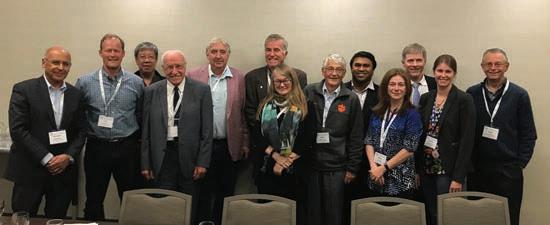
his acceptance he noted, “We (AEG, CGS, and International AEG) have an important role in resolving the global problems resulting from earth systems reacting to the stresses imposed by a changing climate. Sustainability planning needs geological expertise in alleviating natural hazards which are increasingly severe.”
In recognition of Keith’s extensive influence on the profession, the TRB is developing the A. Keith Turner Lifetime Achievement Award. In 2022, the GSA held a specialty memorial session in his honor, “Unto the Hills: A Career of Advancements in Digital Mapping, Computer Modelling, Environmental Hazards and the Collaborations Made Along the Way.”
In addition to his career, Keith was most proud of his family. He was a devoted husband and father. He always took more pride in his children’s accomplishments than his own. Keith, Sandy, and their family had a love for worldwide travel, with favorite destinations being Lugano, Switzerland, and Death Valley National Park, U.S. Keith is survived by his three adult children: Cameron, Melissa, and Bryan. Sandy passed away from amyotrophic lateral sclerosis (ALS) in 2014.
(August 26, 1954 – December 14, 2023)
Gary Luce’s membership in AEG began as a student while attending the University of Nevada, Reno (UNR), Mackay School of Mines, currently the Mackay School of Earth Science & Engineering. He eventually became the AEG National President, serving in 2013–2014, and reinvigorated the AEG Great Basin Chapter, which was named the Chapter on the Rise in 2022. During and between those achievements he served on many AEG committees and boards, in which he helped implement sound fiscal and organizational changes that are ingrained in AEG policies. In 2020 Gary received the Floyd T. Johnston Service Award from AEG for his outstanding active and faithful service to the Association.
Gary spent many years becoming a leader in his chosen profession. His illustrious career spanned more than forty years. He earned degrees in Mining Geology (BS, 1979) and an additional BS and MS in Geological Engineering in 1992, and he was a licensed engineer in both NV and CA. While Gary was an exceptional engineering geologist who added considerably to organizational affiliations (American Society of Civil Engineers and AEG) and the workplace, he was always considerate, lending his expertise and patiently talking through complex solutions. Gary will be remembered as a mentor and friend to many just starting their careers. He was always willing to “pitch in.” When he did so, his wisdom extended from engineering into management, which cannot be taught. It was inherent in Gary to work out all kinds of solutions, both technical and personal.
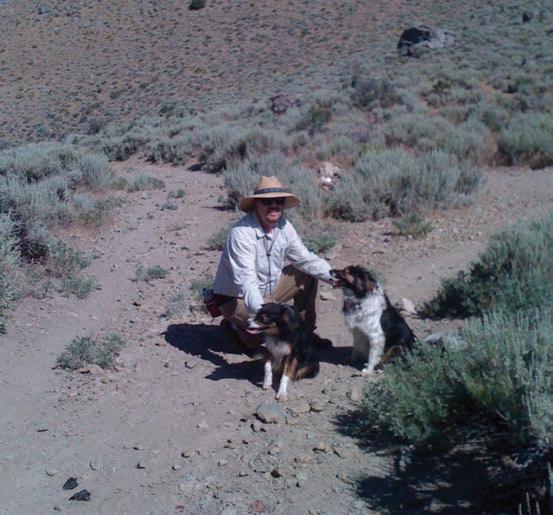
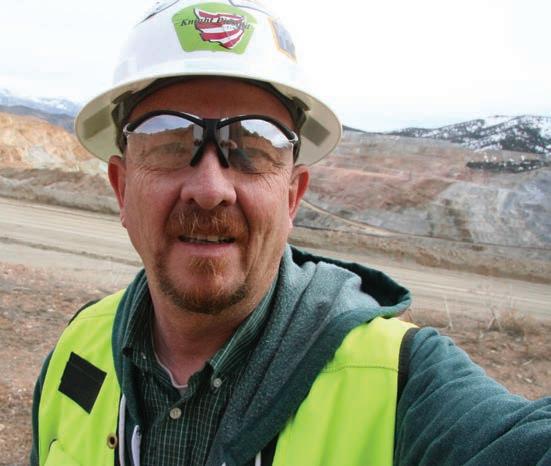
While he worked on many projects, one stands out for which he will be remembered: the “reopening” of tunnels for the historic Virginia & Truckee Railroad from Gold Hill to Carson City, NV, while working for Resource Concepts, Inc. He went on to work for Wood Rodgers, Inc., and was very pleased to be alongside his lifelong friend and colleague Jim Koch.
Gary and his wife, Leigh, loved the outdoors, hiking, skiing, and whitewater rafting. Their Border Collie and Australian Shepherd mixes were the loves of their lives. Gary’s eyes would light up as he recounted adventures, reminding us that life is meant to be lived fully.
Gary and Leigh moved to Oracle, AZ, where they resided in a retirement community, although he never fully retired. He continued to work remotely on projects with Wood Rodgers, based in Reno, NV; served as advisor to the AEG Great Basin Chapter; and chaired the AEG Foundation Robert J. Watters Scholarship Selection Committee.
In the words of his co-workers, Gary was there for you— always. His phone was never off limits, and his wisdom flowed freely. He truly was one of a kind, a beacon in the field of geotechnical engineering who touched the lives of many. He was a good-hearted person, always making sure he supported the people around him as much as himself.
“We bid farewell to a remarkable soul. Gary Luce, your legacy lives on in the projects you championed, the knowledge you imparted, the kindness you shared. May your spirit continue to inspire us as we forge ahead, guided by the memory of your unwavering dedication.” ~ Justin McDougal, Wood Rodgers, Inc.
Memorial contributors: Diane Phillips-Ferree, retired friend and colleague; James Koch, Wood Rodgers, Inc., AEG Member; Justin McDougal, Wood Rodgers, Inc., AEG Member; Merrily Graham, AEG Great Basin Chapter Chair; David Bieber, AEG 2005–2006 President
Gary’s AEG Achievements:
• UNR Student Chapter Member and President, 1989–1992
• Great Basin Chapter/Section Board Member, 1994–1997, and 2017–2018
• Instrumental in the process to change the Great Basin Chapter of the Southwestern Section into the Great Basin Section, a change that was approved in 1995
• Great Basin Section President, 1996–1997
• Co-Chair of 2002 AEG/American Institute of Professional Geologists Joint Annual Meeting in Reno, NV
• AEG Board of Directors, 2011– 2016 (AEG 2014–2015 President)
• Co-Chair of 2009 AEG Annual Meeting in Lake Tahoe, CA and NV
• Co-Chair of 2018 AEG/International Association of Engineering Geologists joint meeting in San Francisco, CA
• K–12 Committee Chair, 1998
• Member of the AEG Committee on Memorials, Biographies, and Citations
• Member of AEG Great Basin/Southwestern Sections Committee on the “Guidelines for Evaluating Potential Surface Fault Rupture/Land Subsidence Hazards in Nevada,” adopted by the Nevada Earthquake Safety Council
• Organizer/Field Trip Leader for Seismic Hazards Field Trip along the Genoa Fault, 1997
• AEG Foundation (AEGF) Board Member, since 2016
• AEGF Marketing Committee Chair, 2019
• Co-Founder with William Gates of the Watters Scholarship, 2018
• Recipient of the Floyd T. Johnston Service Award, 2020
To advertise in AEG News, email advertising@aegweb.org
Gravity for: Aquifer Studies
Sink Hole Dectection
Locating Underground Tanks
Voids/Cavity Dectection
Finding Karst Hazards

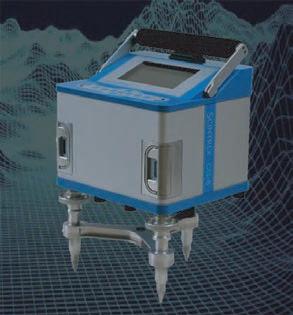
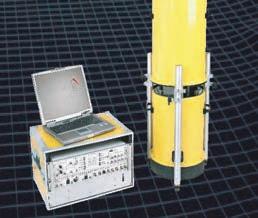


Post a position if you need high-quality, well-prepared workers. And job seekers can search the board for career advancement opportunities. This is a major perk of AEG membership.
→ Visit https://www.aegweb.org/job-board
Elections for the Directors of Regions 3, 5, and 8 will be conducted this Summer. If you are an eligible voting member of one of these Regions (all members except Student or Teacher), you will receive a ballot in your email inbox. This ballot will have a link to the AEG website form where you will login with your membership credentials to record your vote.
REGIONS HOLDING ELECTIONS:
Region 3 - Pacific
Region 5 - Mountain Prairie
Region 8 - South East

For more information on region boundaries: https://www.aegweb.org/regions-chapters
Exhibiting and sponsoring at AEG’s Annual Meeting is effective advertising that builds lasting recognition and goodwill for your company. We expect more than 500 attendees at our 67th Annual Meeting in Philadelphia on September 10–14, 2024.
ALL SPONSORS AND EXHIBITORS receive these BASELINE benefits:
■ Listing in Program with Abstracts available to all attendees on a USB drive, link on the Annual Meeting website, and emailed to our membership worldwide
■ Logo on the AEG Annual Meeting website
■ Ability to place your promotional materials in the attendee’s registration packets
■ Your logo on signage at the Annual Meeting
ANNUAL MEETING PREMIUM EVENT PACKAGE – $3500 ($4995 Value)
■ Premium corner exhibit booth
■ Two full meeting registrations
■ Exclusive sponsorship of the opening session or meeting lanyard
■ Mobile app advertising
■ Your logo on the attendee registration bag
■ Pop up banner at registration
■ Full page ad in the program with abstracts
Other sponsorships available as well. See www.aegannualmeeting.org for complete details.
ANNUAL MEETING GOLD EVENT PACKAGE –$2995 ($4495 Value)
■ Premium corner exhibit booth
■ Two full meeting registrations
■ Exclusive sponsorship of the exhibitor hosted luncheon or icebreaker
■ Logo on your booth location on the exhibit hall map
■ Pop up banner at the event you sponsor
■ Half page ad in the program with abstracts
ANNUAL MEETING SILVER EVENT PACKAGE –$2500 ($4000 Value)
■ One full meeting registration
■ Exclusive sponsorship of the closing reception, student/ professional networking session, or special event
■ Exhibit booth
■ Complimentary ticket to your sponsored event
■ Quarter page ad in the Program with Abstracts
EXHIBIT BOOTH ONLY – $1400
■ 8-foot x 10-foot booth, including 6-foot skirted table, two chairs, sign, power, and wireless internet
■ One full meeting registration
As previously reported, AEG is providing support to the Virginia Geologist Workgroup (VGW) to strengthen the Virginia Code pertaining to the practice of geology. The certification of Virginia geologists has been under the threat of elimination. During last year’s 2023 General Assembly, a bill was introduced that called for the elimination of the Certification of Geologists in VA. Fortunately, that bill did not become law. Nonetheless, seizing on the support garnered during the 2023 General Assembly, a small group of VA geologists, the VGW, banded together with AEG to pursue an offensive position with legislation that strengthens geology certification in the Commonwealth.
R. Drew Thomas, CPG

AEG-supported House Bill 287 and Senate Bill 184 were identical, both modernizing the definition of the practice of geology so that it more accurately captures the important and widely varied work that geologists do in VA. HB 287 (Wiley) passed the House of Delegates 98-0 and passed the Senate 39-0. Similarly, SB 184 (Rouse) passed the Senate 39-0 and the House of Delegates 98-0. The Bills were significant in that, among other things, they define “the practice of geology” in Virginia as a “professional service” to “enhance and protect the health, safety, and welfare of the public and the environment”.
These two bills finished their journeys through the General Assembly with a couple of weeks remaining until adjournment. Just a few hours before the 11:59 pm action deadline on March 8, 2024, news was delivered that the Governor Youngkin had signed the two bills into law. Having been signed by the Governor, HB 287 (Wiley) and SB 184 (Rouse) will now take effect in VA on July 1, 2024.
We are thankful that the Governor acted favorably upon this legislation, and we are incredibly grateful to our patrons, Delegate Bill Wiley (R-Winchester, VA) and Senator Aaron Rouse (D-Virginia Beach, VA) for their hard work on this issue. We are also thankful to each of you who contributed to these efforts.
Our work with the VGW is not complete; we will build on our successes of working together and continue efforts to strengthen geology-related law in VA. AEG is employing the services of Williams Mullen in Richmond, VA, for lobbying efforts. The group has been fantastic to work with and is highly effective. The VGW is currently raising funds to support lobbying efforts for the 2025 General Assembly. AEG is
$60,000
$50,000
$40,000
$30,000
$20,000
$10,000
$0
$22,745
matching VGW funds, and collectively we have a great start to fund the efforts required for the 2025 session. For more information and postings visit the AEG website (https:// www.aegweb.org/virginia-geologist-workgroup) under the Licensure tab, and consider being a contributor to this important work of strengthening the geology profession in Virginia.
Kaitlin L. Reiman, Secretary
The Mile High Chapter has had another fantastic year of meetings enriched with informative talks and enjoyable social events, bringing together our community of professionals. We started our fall meetings at a new location, the highly recommended Cheese Ranch in Golden, CO. We delved into various topics, starting with a focus on dams. Kristi Ainslie with AECOM discussed “Determining Treatment Requirements for High-Permeability Faults in a Dam Raise Foundation,” while Kyle Kittle from Stantec presented on the “Chimney Hollow Dam Foundation Grouting Program.” In October, Ana Vargo with the U.S. Department of Agriculture shared insights into the “Rehabilitation of Tibble Fork Dam” in Utah County, UT.
Continuing our engagement with critical infrastructure, in November, Ben Arndt from RJ Engineering and Nicole Mapes with the Colorado Department of Transportation discussed “Debris Flows and Debris Flow Mitigation” along Interstate 70 in Glenwood Canyon following the Grizzly Creek Forest Fires in 2021.
December brought a delightful change of pace with our Cheesy December Social at Cheese Ranch. Attendees enjoyed a festive spread of charcuterie boards, fondue, and desserts, fostering camaraderie and goodwill before the holidays. As we welcomed the new year, we found a spacious and welcoming venue at New Terrain Brewing in Golden, CO.
In January, we were honored to host Spencer Logan, the Science and Operations Officer with the Colorado Avalanche Information Center (CAIC), who shared insights into the CAIC’s avalanche forecasting, a critical resource for our community’s safety. Additionally, Lisa Dirth shared the story of her son, George Dirth, who lost his life in an avalanche while split-boarding in Grand County, CO, in 2013. In honor of his memory, the Dirth family established the George Dirth Memorial Scholarship Fund. This initiative aims to support backcountry enthusiasts in CO and UT by providing financial assistance for avalanche education. Their mission is to enhance safety and prevent further tragedies in the backcountry. As the author also has a personal connection to the devastating impact of avalanches, this cause holds a profound significance. To learn more and contribute to the George Dirth Memorial Scholarship Fund, please visit https:// wwgd.systrap.net/George-Dirth-Memorial-Scholarship-Fund.
February’s meeting featured Brian Collins, Senior Geotechnical Engineer from BGC Engineering, discussing the Pretty Rocks landslide impacting Denali Park Road in AK, drawing significant interest and engagement from attendees.
In March we hosted students from the Colorado School of Mines, showcasing their research through poster presentations and speakers. Poster presentations
included Bennett Emmons, “Classification of Rockfall Clusters for Point-Cloud-Based Rockfall Monitoring”; Jessie Hiatt, “Underground Coal Fire Detection through Multispectral Analysis, Terrain Subsidence Assessment, and Geospatial Analytics”; Jacob Hollander, “Development of Photogrammetric Rockfall Database and Analysis of Trends at a Rock Slope along I-70W, West of Idaho Springs, CO”; and Ellie Longar, “Influence of Buttressing and Lateral Confinement on a Large Block Prior to Rockfall.” The speakers were Hayden Jacobson, “Modelling Compositional Influence on Debris-Flow Runout,” and Cornelis Reijm, “Postfire Debris Flows and the Environment: Analyzing Linkages between Post-Wildfire Infiltration and Environmental Aspects in the Western US.” The event was a testament to the bright future of our industry, and we extend our gratitude to our sponsors for helping raise $2,875!
The Mile High Chapter’s April schedule had two exciting meetings. On April 2, we were honored to host the Jahns Distinguished Lecturer, Cynthia Palomares, who delivered a thought-provoking presentation on “How Climate Change Impacts Infrastructure.” President Sarah Kalika is slated to visit on April 30!
Frances Schultz, Region Director
Region 10, 2024 Update
Since the Annual Meeting, this fall the New York-Philadelphia (NY-P) Chapter has held monthly dinner meetings. Meetings follow a format of announcements and updates preceding a presentation by a speaker. Attendance has ranged from 25 to 40 people. In January, all three of the NY-P student chapters; Rutgers; and our newest student chapters, Lafayette and Rowen, sent students to attend the Chapter meeting. Presentations have included “Scalable Groundwater Model Workflow for Coal Combustion Residuals (CCR) Sites,” “Development of Conceptual Site Models Using 3D Data Visualization and the Application of Environmental Sequence Stratigraphy,” “Geohazards: Natural Disaster Threats in New Jersey,” and “Using Elevated Concentrations of Chromium and Nickel as an Indicator for the Presence of Chrysotile Asbestos in Serpentinite Rock Units . ” Furthermore, AEG had an exhibitor’s table at the Licensed Site Remediation Professional Association’s New Jersey Site Remediation Conference on April 3rd. With around 700 Licensed Site Remediation Professionals in attendance, this conference provides great exposure to other environmental professionals. Our Vice Chairperson, Jim Peterson, presented two short courses, and his company, Princeton Geoscience, was the Master Sponsor for the conference.
Benson Chow, RPG, RM-SME
On March 9, the Texas Chapter held its winter meeting in Wallisville, TX, at the Anahuac National Wildlife Refuge Visitor Center. A casual networking event was held the night before the meeting at BreWingZ. The topic of the meeting and field trip was the Turtle Bayou Nature Preserve Brownfield Restoration Project. Stephanie Martinez from the U.S. Fish and Wildlife Service, Claudia Sandoval from ChambersLiberty Counties Navigation District (CLCND), Leslie Etzel from the Railroad Commission of Texas, and Jeffrey Fato from Galveston Bay Foundation provided presentations discussing the history of the area, restoration of the brownfield site, water resources in Lake Anahuac, and management of the Turtle Bayou Nature Preserve. The first field trip was to CLCND’s main pump station in Anahuac, TX, where we toured the intake structure, pump house, and canal water delivery system. It was fascinating to learn about the amount of water that CLCND provides through their pumping and canals operation. The second field trip was to the Turtle Bayou Nature Preserve, where we hiked and looked at the restoration and management of the Preserve. Since the restoration, the Preserve has developed into a birding hotspot where historical oil and gas operations once stood. A donation to Friends of Anahuac Refuge was made for hosting our winter meeting. Friends of Anahuac Refuge is a nonprofit organization committed to preserving and enhancing the refuge through conservation, research, and education.
Jen Thomas, PG, Chapter Chair
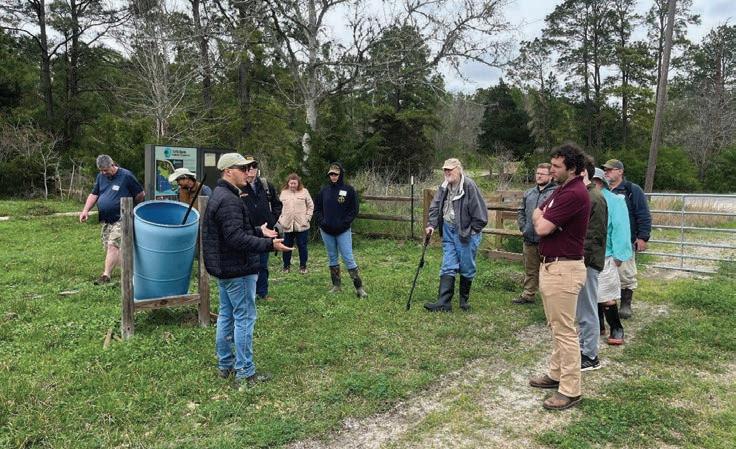

The Carolinas Chapter has gotten back to “normal” after our hiatus for Covid. We have three hundred members, over half of which are students. Our Chapter has resumed our quarterly Chapter meetings and brewpub socials. We’ve enjoyed having our students resuming participation in our Chapter meetings—our Chapter pays for their dinners, so commonly we have five to fifteen students at each Chapter meeting. Recent Chapter meetings have been held at the
High Wire Brewery in Asheville, where, our speakers were Dr. Lisa Raleigh and Dr. Renee Fortner, whose talk was titled “Promoting Clean Water + Climate Resiliency in the French Broad River Watershed”; at the Red Oak Brewery in Whitsett (near Greensboro), where our speaker was Jahns Lecturer Vincent Cronin, whose talk was titled “How Can Engineering Geology Help Society Meet the Challenge of a Changing Climate”; and at the Olde Mecklenburg Brewery in Charlotte, where our speaker was Jahns Lecturer Cynthia Palomares, whose talk was titled “How Climate Change Affects Infrastructure.” Our Chapter Vice Chair, Jonathan Gerst, organized Cynthia’s visit, and during her week with us,
she made presentations at the University of North Carolina (UNC) at Asheville, Western Carolina University, Appalachian State University, Clemson University, East Tennessee State University, and UNC Charlotte prior to her dinner presentation at Olde Meck. Last fall, Dr. Cronin made presentations during his visit to geology students at North Carolina State University (NCSU), East Carolina University, the College of Charleston, and the University of South Carolina.
Our spring Chapter meeting was held at Clouds Brewing on April 11, where our speaker was Kim Nimmer, whose talk was titled “What’s the Big Deal with Small Plastic?” The Interstate Technology and Regulatory Council (ITRC) has called microplastics a contaminant of emerging concern, so her talk was of interest to our Chapter’s environmental geologists. Kim formerly led ITRC’s Microplastics Team, which published their Online Guidance Document for microplastics in February 2023.
Our Chapter typically holds two field trips a year. In October, we held the field trip “Geological Field Course to the Grandfather Mountain Area,” which was led by Bart Cattanach, Ashley Lynn, Brennan Trantham, and David Korte of the North Carolina Geological Survey (NCGS). We had eighteen attend this field trip, which provided seven continuing education hours. The geology boards of both North and South Carolina require continuing education to maintain professional registration as a geologist. Our spring field trip, “Field Course to Explore the Colon Cross-Structure,” will be led in April by Phil Bradley of the NCGS and independent consulting geologist Ron McDaniel. We have twenty-seven signed up for that trip.
The Carolinas Chapter has had a Visiting Professionals program since 2007, prior to AEG’s formal commencement of that program. We often bring in an environmental geologist, an engineering geologist, and a public-sector geologist, each of whom talks about their career and finding jobs. The Chapter provides pizzas and soft drinks as an inducement for students to attend and learn about careers in geology. This spring, environmental geologist John Sherrill, engineering geologist Meredith Ambrose, and public-sector geologist Joshua Hanks presented at NCSU. Environmental geologist Emily Hermann, engineering geologist Dana Goodnight, and part-time publicsector geologist Rick Kolb presented at Wake Technical Community College, which has the only student Chapter of AEG in a community college. We’ve planned Visiting Professional presentations next month at East Carolina University, Appalachian State University, and UNC Charlotte.
One important effort in the first quarter of 2024 has been soliciting renewals of our Chapter sponsors and finding new sponsors. We have twenty-three Chapter sponsors this year, seven of which are new, and their $8,000 in fees enables us to offer many benefits:
• the Carolinas Scholarship to a geology student in North or South Carolina ($3,000 last year)
• free dinners for students at our Chapter meetings
• subsidized admission to dinners at our Chapter meetings

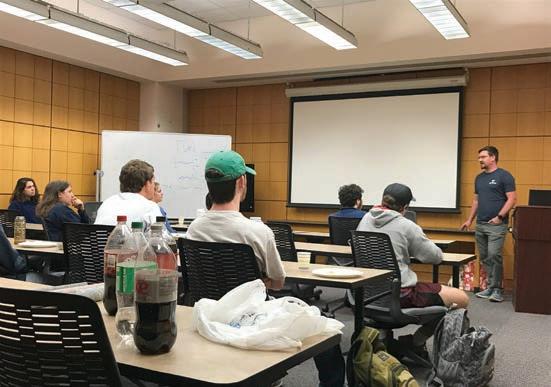
• expense support for annual visits to our Chapter by the AEG Presidents and Jahns Lecturer
• pizzas and soft drinks at our Visiting Professional presentations
Several of our sponsors have been sponsors for more than ten years, and we truly appreciate their support.
Our Chapter holds social events on an irregular schedule. Last year our Social Chair, Adam Phillips, organized a Beers & Baseball social, which started at Foothills Brewpub in Winston-Salem and moved to a Winston-Salem Dash Minor League Baseball game. An upcoming social event this spring will be a walking tour to view the building stones in buildings in downtown Raleigh, to be led by Amy Pitts, the geologist for education and outreach at the North Carolina Department of Environmental Quality.
The Carolinas Chapter has partnered with the Groundwater Professionals of North Carolina, which holds two one-day “mini-conventions” a year with technical presentations, an annual golf tournament, and other social events. We advertise each other’s activities, and AEG members often attend their events. The topics of their May mini-convention will be PFAS at landfills and groundwater availability, supply, and saltwater intrusion.
Doug Johnston, Secretary
After several years of Covid-related hiatus, AEG’s Inland Empire Chapter relaunched a leadership team with a new officer election process in December 2023. Our 2024 board of officers includes Chapter Chair Lisa Battiato of Geocon West; Vice-Chair North Mike Cook of Kleinfelder; Vice-Chair South Kerry Cato of California State University, San Bernardino (CSUSB); Treasurer Mark Doerschlag of Aragon Geotechnical; and Secretary Doug Johnston of Petra Geosciences.
Our first official in-person Chapter event since February 2020 had twenty attendees and was held on December 6, 2023, at Escape Brewery in downtown Redlands. Because of the large geographic range of the Inland Empire, the Chapter uses roving meeting locations, north one month and south the next, to serve our membership. We welcomed guest speaker Darrin Hasham, PG, CEG, who works as an Associate Geologist at Earth Systems Pacific in San Luis Obispo, CA, and is the AEG Director for Southern California. Darrin presented a history on how wine and caves became associated with each other and why wine caves are currently attractive to wineries; he used a case study to present construction methods, testing and observation performed before and during construction, and challenges associated with these mined structures.
Our January 17, 2024, meeting was held at Aftershock Brewery in Temecula, CA. On the thirtieth anniversary of the 6.7 M w Northridge Earthquake in the San Fernando Valley area, we welcomed guest speaker Gerry Kasman, CEG, Senior Geologist and Vice-President at Geocon West, Inc., in Burbank, CA. Gerry presented on the various fault hazard exploration techniques and methodologies in both deep alluvial sites and for urban/limited-space environments. Various methods, or combinations of methods, should be considered when making field exploration decisions; the preplanning stage and project team communication is of utmost importance.
Our February meeting was held at Johnny Carino’s Italian restaurant in Eastvale, CA. Following a lecture to students at CSUSB earlier in the day, our honored guest was none other than the current AEG President, Sarah Kalika, PG, CAC, and Founder/Principal Geologist at DiabloGeo Environmental Consulting. Sarah first presented a Cliffs Notes version of the “State of the Association,” reviewing our current membership numbers, demographics, 2023 financial summary, volunteer opportunities on operational committees and technical working groups, scholarships for students, and information about the 2024 Annual Meeting in Philadelphia. Later, her technical presentation discussed field geologists’ health and safety protections during collection of soil/groundwater samples and how geologists can determine what they are handling prior to collecting samples.
Lastly, our March meeting was held at the Pizza Factory restaurant in Temecula, CA. Mandro Eslami and Ryan Bulatao
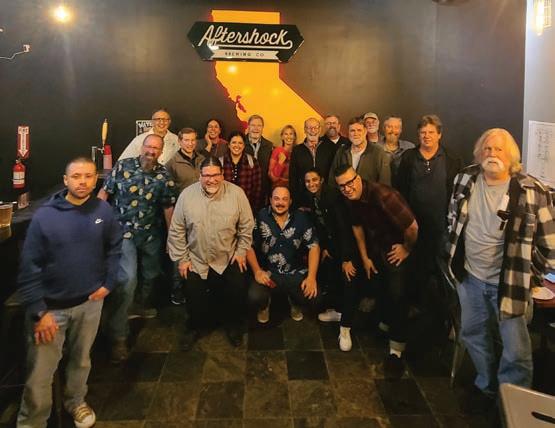
[Above] In January, the Inland Empire Chapter met at the Aftershock Brewery in Temecula, CA.
[Below] AEG Region 2 Director Darrin Hasham presenting on wine and caves at the Escape Brewery in Redlands, CA.
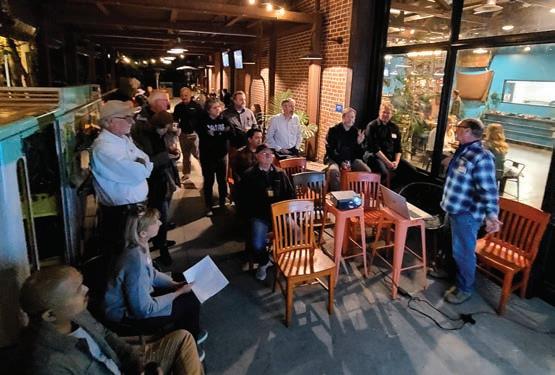
of Western Ground Improvement, Inc., based in Irvine, CA, discussed alternative deep foundation systems to improve less-than-ideal foundation conditions. This is an interesting topic for all professional geologists, but very important in understanding these methods for practicing and aspiring CEGs. The discussion covered the design and applications for utilizing Geopiers, otherwise known as rammed aggregate piers, which are becoming a more common alternative to expensive driven piles. Depending on the site subsurface geologic and geotechnical conditions, the project design, and the logistics of neighboring improvements, three types of systems are commonly used: the original GP3 system, the impact system, and the hybrid X1 system. In addition to building structures, a Geopier and Plate Pile system can also be used in shallow slope stabilization.
Merrily Graham, Chair
AEG Great Basin Chapter was the recipient of the 2023 “Chapter on the Rise” award. The certificate was framed and has been proudly on display throughout the meeting season. Our Fall 2023 program featured Paul Schwering, Principal Geoscientist – Sandia National Laboratories, presenting “Geothermal Energy in Nevada – A Tour (Some!) Hot Research Topics” on October 19; Kyle Roerink, Executive Director Great Basin Water Network, presenting “Is Groundwater Exportation Viable in Northern Nevada?” on November 9; and Dr Kenneth E. Nussear, Geography Professor, University of Nevada-Reno (UNR), presenting “Expanding the Ability To See and Measure the Environment Using Drones – UAS” on December 14.
On January 16, 2024 Dr, Sherif Elfass, Associate Research Professor of Civil Engineering at UNR, presented a thorough overview of the design, fabrication, and commissioning of the largest biaxial laminar soil box in the United States. The successful testing was conducted at the Soils Lab on the UNR Campus. Dr. Elfass is also the Manager of the Industry Support Group, leading the effort to assist companies with developing products, improving competitiveness, and performing product qualification.
The Jahns Lecture series in February was a great success. Distinguished Lecturer Cynthia Palomares enjoyed the two-day session, hosted by members and students, who made her trip to Reno a memorable one. Ms. Palomares, PG, PE, presented “Regulatory Requirements for Hazardous Waste Management Units and How These Requirements are Applied to a Case Study in West Texas” on February 15, followed by a campus lecture on “How Climate Impacts Infrastructure” on February 16.
Dr. James E. Faulds, NBMG Director/State Geologist/ Professor, presented “Recent Activities of the Nevada Bureau

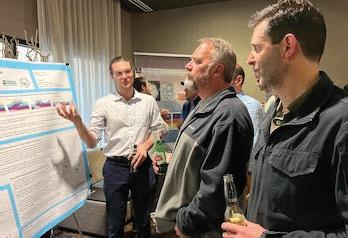
of Mines and Geology (Nevada’s state geological survey): Applied Research Focused on Natural Resources and Geologic Hazards” at the Chapter’s March 14 meeting.
The Chapter held its 2023-24 meeting season finale on April 11th with a traditional annual “Student Night 2024” awards celebration. Three presenters and four poster presentations were the focus of the evening’s competition for cash prizes and gift cards. The meeting featured presentations by Caleb Ring, M.Sc. in Geological Engineering, on “Hydraulic Geometries and Scaling Relationships for Runoff- and Landslide-generated Debris Flows;” Thomas Kaps, MSc in Chemical and Materials Engineering, on “Passive Acid Mine Drainage Treatment at Perry Canyon, NV;” and Annika Gonzalez, MSc in Geology on “The Surface Exposure Dating of Moraines at El Tatio, Chile.” Poster presentations were made by Angelique Depauw, BSc/ MSc in Hydrogeology, on “Investigating the Degradation Mechanisms of Bioplastic Straws;” Annie Patton, PhD in Geophysics, on “Seismic coda-derived source properties of small earthquakes near Rock Valley, Nevada;” Priyasha Negi, PhD in Geology, on “Enhanced chemical weathering of Bay of Bengal shelf sediments during glaciation low-stand: Insights from geochemical and Sr-Nd isotopic study;” and Vivian Rosas, MSc in Geophysics, on “A comprehensive Analysis of Station Performance for the Nevada Seismological Laboratory Network Stations Near Reno, Nevada.”
Volunteer for 8 hours to earn a free meeting registration! Contact Heather Clark: heather@aegweb.org
→ Sign up for our Mentor Program: Pairs students with professionals for advice and support before and during the Annual Meeting.
→ Student/Professional Reception: The perfect place to meet your future employer. Tues, Sept 10, 5:15–6:15pm.
→ Young at Heart Student/Professional Event: Free networking event aboard the Moshulu Tall Ship. Tues, Sept 10, 8–10pm.

Bill Mikalik, DMV Chapter Chair, & Visty Dalal, AEG Membership Committee Co-Chair
AEG President Sarah Kalika visited the AEG DC-MarylandVirginia (DMV) Chapter in Frederick, Maryland, on March 12, 2024, and gave a great presentation titled “Using Elevated Concentrations of Chromium and Nickel as an Indicator for the Presence of Chrysotile Asbestos in Serpentinite Rock Units.”
Sarah’s talk detailed her research that has spanned throughout the West Coast from California to Washington state and on the East Coast from Maryland to Vermont, covering areas in New Jersey and New York. The gist of the talk was how chromium (Cr) and nickel (Ni) are found in high concentrations in the presence of chrysotile asbestos in serpentinite rock. She delineated areas on the West Coast where there were high concentrations of Cr and Ni in conjunction with high concentration of chrysotile rocks, attributing their presence to subducting margins of the Pacific and North American Plates. In Maryland, she located a quarry in Rockville that showed a similarly high
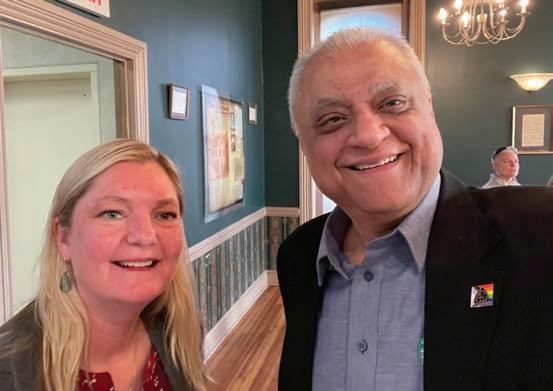

concentration of Cr and Ni along with asbestos. She attributed the high concentration of the elements and asbestos to the Appalachian Orogeny. However, Sarah’s research in the northern region of the Appalachian Mountains in New Jersey, New York, and Vermont, indicated low concentrations of Cr and Ni along with chrysotile asbestos. Sarah is very interested in pursuing this research in tandem with other researchers in the field and subsequently publishing the results.
DMV Chapter officers Bill Mikalik (Chair/Region 9 Director), Savvas Hadjichristodoulou (Treasurer), and Jasmine Rollins (Secretary) all greeted and welcomed Sarah to the DMV meeting along with fifteen other DMV Members and guests. Sarah’s talk was preceded by a sumptuous dinner served at the historic Brewer’s Alley in Frederick.
Dr. Visty P. Dalal, Co-Chair, AEG Membership Committee (MemCom), took the opportunity to inform the members about the work that MemCom has done in the past six months in reaching out to both existing and prospective members to enhance recruitment and retention in AEG. Sarah and Visty also shared the newly created Membership Brochure with DMV Members.
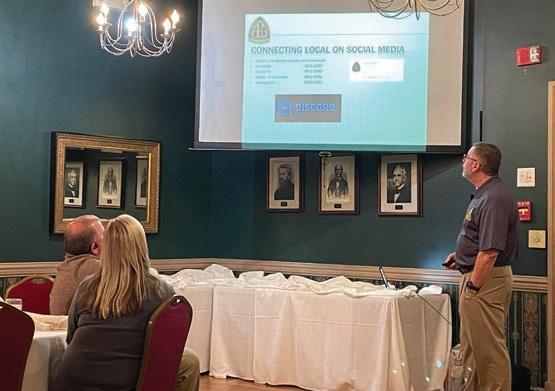

Jerusalem Miramontes, Environmental and Engineering Geoscience Club President
We wanted to take a moment to express our sincere gratitude to the entire team at AEG for organizing an incredible trip to Anza-Borrego Desert State Park in Borrego Springs, California, on April 20, 2024. Cal State LA Chapter Members Maria and I had a fantastic time, and we are incredibly grateful for the opportunity to experience such an informative and enjoyable outing.
The expertise and knowledge shared by the geologists present during the trip were truly invaluable. We learned so much about the geology of the area and gained a deeper understanding of the natural processes at work in AnzaBorrego. It was both educational and fascinating, and we couldn’t have asked for better guides. From the sedimentary layers to the tectonic forces shaping the landscape, the geologists’ insights provided us with a profound appreciation for the natural wonders we were witnessing. The detailed explanations and engaging presentations made complex geological concepts accessible and intriguing.
Sandstone Canyon, located in the heart of Anza-Borrego Desert State Park, is a spectacular geological formation renowned for its towering walls of weathered sandstone. The canyon, carved over millennia by water and wind, showcases stunning examples of sedimentary rock layers, making it a prime destination for geology enthusiasts and adventurers alike.
During our excursion to Sandstone Canyon, we were thrilled to uncover remarkable geological features that


highlighted the area’s rich history. Among our exciting discoveries were deposits of gypsum. Adding to the intrigue of our journey, we came across fossilized tracks believed to be from ancient camels. These trace fossils provide compelling evidence of the prehistoric fauna that once roamed this arid landscape, adding a layer of historical significance to the already captivating scenery. Additionally, we encountered fossilized ripple marks preserved on bedding planes within the sandstone. These ripple marks are remnants of ancient water flow patterns, providing insight into the sedimentary

California State, Los Angeles Student Chapter continued
processes that shaped the landscape millions of years ago. Their presence adds to the tapestry of geological phenomena visible in the canyon, allowing us to visualize the dynamic environmental conditions of the past.
Moreover, the entire experience was tons of fun! Exploring the breathtaking landscapes and unique geological formations was an adventure we will never forget. The dramatic desert vistas, towering rock formations, and diverse flora and fauna created a stunning backdrop for our exploration.
Each hike and excursion offered new surprises and discoveries. Whether we were traversing rocky canyons, marveling at ancient fossils, or simply soaking in the serene desert atmosphere, every moment was filled with wonder and excitement. We appreciated every moment of the trip and feel privileged to have been a part of it.
Thank you once again for organizing such a memorable outing. We genuinely hope to keep in touch and participate in more outings like this in the future. Maria and I are eager to continue our journey of discovery and adventure with AEG. The Anza-Borrego trip has not only enriched our knowledge but also deepened our connection to the natural world. We look forward to future opportunities to explore, learn, and share unforgettable experiences with the AEG community.
Our heartfelt thanks go out to AEG and everyone involved in making the Anza-Borrego trip a resounding success. The memories we created, the knowledge we gained, and the friendships we formed will stay with us forever. Here’s to many more adventures together!

Tom DOE, CHAPTER CHAIR
The Puget Sound Chapter had a highly successful student career night in February. The program was online using the SpatialChat platform, which creates “rooms” where people can mill about and have conversations with those in proximity to their avatars. Nine companies and two state agencies gave short presentations on their organizations, and each had a table in the virtual room where students could come and talk. Over sixty students from at least six schools attended. Cynthia Palomares gave the Jahns Lecture in early March, and we look forward to our annual student night in April, where we will have short talks and poster presentations of student research activities. We are planning a June field trip with Shannon & Wilson’s Bill Laprade at Seattle’s Discovery Park, a repurposed coastal defense base with type sections of glacial units and spectacular landslides associated with the glacial stratigraphy.
Ken Neal, Contributor
The Nisqually Chapter has had an eventful year of monthly meetings featuring great speakers and other activities. In October, Jim Struthers presented a talk, “Emergency Response, Mitigation and Design of Rock Cuts 1-9, SH-55, Smith Ferry, Idaho.” In November, Mike Piechowski presented “Well Rehabilitation in the Lower Columbia River Valley: A Case Study Implicating Drilling Techniques.” In December, we held a nontechnical meeting consisting of a white elephant gift exchange, nontechnical talks mostly about vacations, and a brief talk by Ken Neal about 50 years of hiking in the Wallowas.
At our February meeting, we learned about “Advances in Rockfall Protection: A New Design Tool for Attenuators,” presented by Tim Shevlin. In March, Jahns Distinguished Lecturer Cynthia Palomares presented a talk, “How Climate Change Affects Infrastructure.” In April, we were visited by AEG President Sarah Kalika, who spoke about AEG’s current situation and “Using Elevated Concentrations of Chromium and Nickel as an Indicator for the Presence of Chrysotile Asbestos in Serpentinite Rock Units.” In May, Bill Halbert presented “Humanitarian Hydrogeology or How to See Africa on Someone Else’s Nickel.”
These interesting talks, a convenient venue, good company, good food and drinks, and relatively low costs have attracted new members. Since our discussions are usually available remotely, this allows much greater participation, even from members of other chapters. The Nisqually Chapter has grown dramatically from 9 members in 2017 to 38 members in 2024.





The Journal of the Association of Environmental & Engineering Geologists and the Geological Society of America





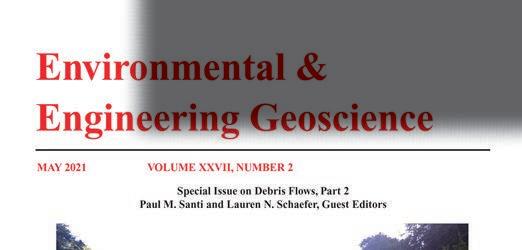



◆ To reach more than 20,000 engineering geology professionals.

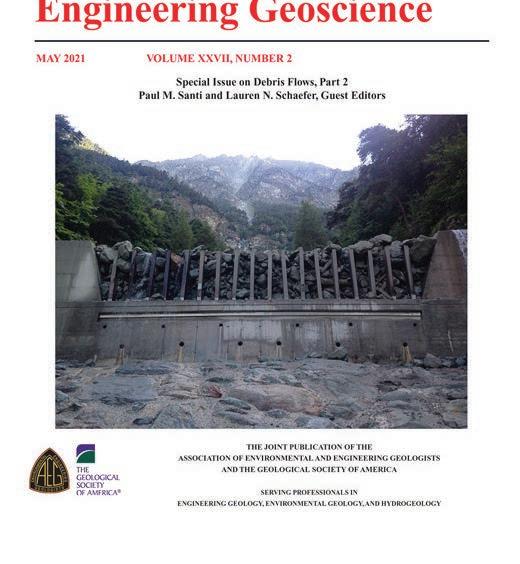





◆ To give your work visibility among other researchers in your field.
◆ To keep the body of knowledge current.

◆ To make your work accessible to a wider audience.
◆ To make your work more discoverable through on-line search engines.
◆ To take advantage of the new Open Access feature.
◆ To become eligible for the AEG Publications Award presented annually to the person or persons responsible for the most outstanding paper published in Environmental & Engineering Geoscience.
Instructions for Authors are in the Style Guide: https://www.aegweb.org/e-eg-supplements
Instructions for Submitting Files: https://www.editorialmanager.com/eeg
If you have questions, please contact a Co-Editor: Thomas Oomen (toommen@olemiss.edu) or Eric Peterson (ewpeter@ilstu.edu).
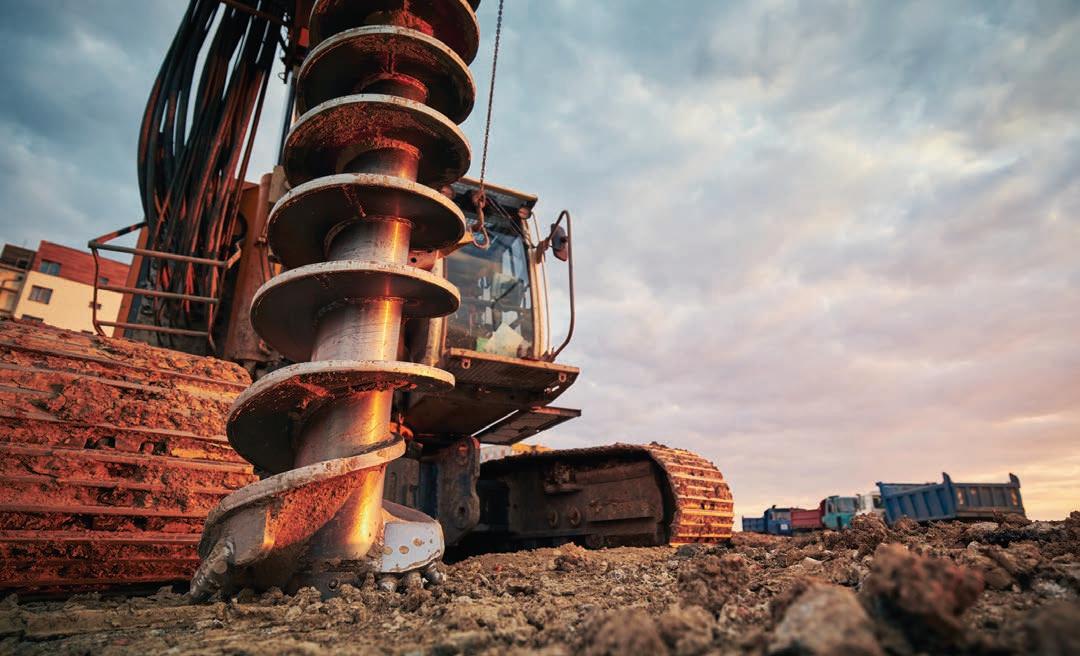
With Penn’s online Master of Science in Applied Geosciences, you can make an impact in environmental geology, hydrogeology, or engineering geology.
• Expand your geoscience or engineering geology knowledge
• Learn from experienced industry experts
• Prepare for your next professional move ahead
Join us on the first Thursday of every month for a Virtual Café to get your questions answered about our online curriculum, program features, and application details.
Details at: www.upenn.edu/msag